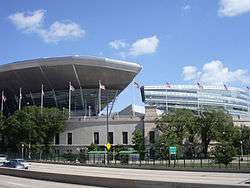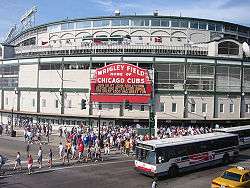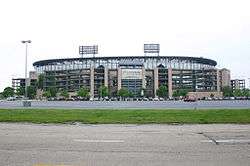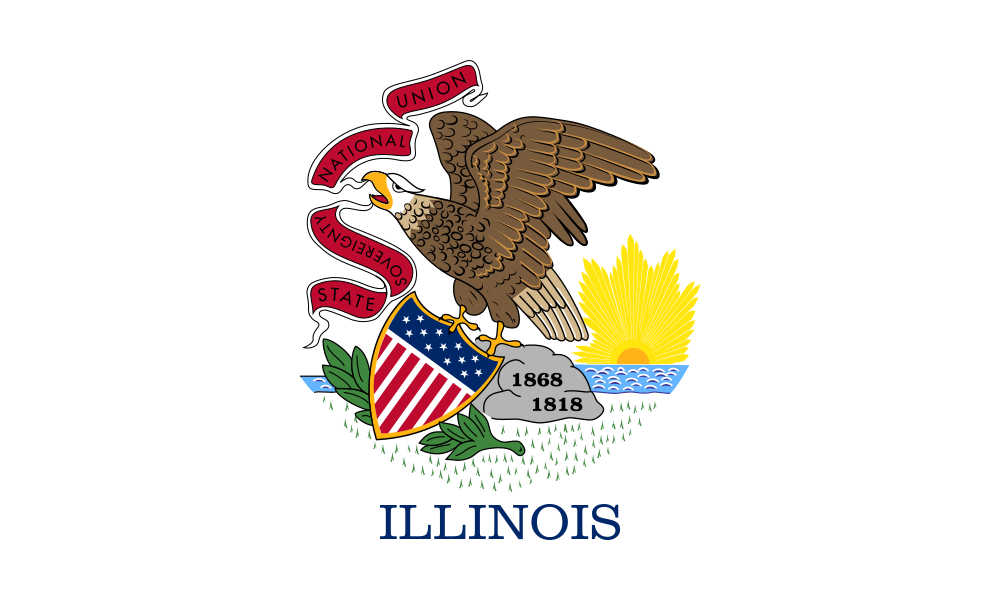Chicago Blackhawks
The Chicago Blackhawks (spelled Black Hawks until 1986, and known colloquially as the Hawks) are a professional ice hockey team based in Chicago. They compete in the National Hockey League (NHL) as a member of the Central Division of the Western Conference. They have won six Stanley Cup championships since their founding in 1926. The Blackhawks are one of the "Original Six" NHL teams along with the Detroit Red Wings, Montreal Canadiens, Toronto Maple Leafs, Boston Bruins and New York Rangers. Since 1994, the club's home rink is the United Center, which they share with the National Basketball Association's Chicago Bulls. The club had previously played for 65 years at Chicago Stadium.[3]
| Chicago Blackhawks | |
|---|---|
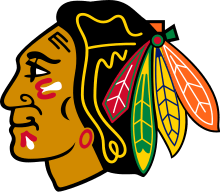 | |
| Conference | Western |
| Division | Central |
| Founded | 1926 |
| History | Chicago Black Hawks 1926–1986 Chicago Blackhawks 1986–present |
| Home arena | United Center |
| City | Chicago, Illinois |
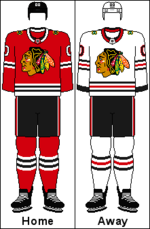 | |
| Colors | Red, white, black[1][2] |
| Media | NBC Sports Chicago WGN Radio (720 AM) |
| Owner(s) | Wirtz Corporation |
| General manager | Stan Bowman |
| Head coach | Jeremy Colliton |
| Captain | Jonathan Toews |
| Minor league affiliates | Rockford IceHogs (AHL) Indy Fuel (ECHL) |
| Stanley Cups | 6 (1933–34, 1937–38, 1960–61, 2009–10, 2012–13, 2014–15) |
| Conference championships | 4 (1991–92, 2009–10, 2012–13, 2014–15) |
| Presidents' Trophy | 2 (1990–91, 2012–13) |
| Division championships | 16 (1969–70, 1970–71, 1971–72, 1972–73, 1975–76, 1977–78, 1978–79, 1979–80, 1982–83, 1985–86, 1989–90, 1990–91, 1992–93, 2009–10, 2012–13, 2016–17) |
| Official website | www |
The club's original owner was Frederic McLaughlin, who owned the club until his death in 1944. Under McLaughlin, a "hands-on" owner who fired many coaches during his ownership, the club won two Stanley Cup titles. The club was then owned by the Norris family, who as owners of the Chicago Stadium were the club's landlord, and owned stakes in several of the NHL teams. At first, the Norris ownership was as part of a syndicate fronted by long-time executive Bill Tobin, and the team languished in favor of the Norris-owned Detroit Red Wings. After the senior James E. Norris died in 1952, the Norris assets were spread among family members and James D. Norris became owner. Norris Jr. took an active interest in the team and under his ownership, the club won one Stanley Cup title in 1961.
After James D. Norris died in 1966, the Wirtz family became owners of the franchise. In 2007, the club came under the control of Rocky Wirtz, who is credited with turning around the organization, which had lost fan interest and competitiveness. Under Rocky Wirtz, the Blackhawks won the Stanley Cup three times between 2010 and 2015.
Franchise history
Founding
On May 1, 1926, the NHL awarded an expansion franchise for Chicago to a syndicate headed by former football star Huntington Hardwick of Boston. At the same meeting, Hardwick arranged the purchase of the players of the Portland Rosebuds of the Western Hockey League for $100,000 from WHL president Frank Patrick in a deal brokered by Boston Bruins' owner Charles Adams.[4] However, only one month later, Hardwick's group sold out to Chicago coffee tycoon Frederic McLaughlin.[5]
McLaughlin had been a commander with the 333rd Machine Gun Battalion of the 86th Infantry Division during World War I.[6] This division was nicknamed the "Blackhawk Division" after a Native American of the Sauk nation, Black Hawk, who was a prominent figure in the history of Illinois.[6] McLaughlin named the new hockey team in honor of the military unit, making it one of many sports team names using Native Americans as icons. However, unlike the military division, the team's name was spelled in two words as the "Black Hawks" until 1986, when the club officially became the "Blackhawks," based on the spelling found in the original franchise documents.[7]
The Black Hawks began play in the 1926–27 season, along with fellow expansion franchises the Detroit Cougars (now the Detroit Red Wings) and New York Rangers. The team had to face immediate competition in Chicago from Eddie Livingstone's rival Chicago Cardinals, which played in the same building. McLaughlin took a very active role in running the team despite having no background in the sport; he hired Bill Tobin, a former goaltender who had played in the Western League, as his assistant, but directed the team himself. He was also very interested in promoting American hockey players, then very rare in professional hockey. Several of them, including Doc Romnes, Taffy Abel, Alex Levinsky, Mike Karakas, and Cully Dahlstrom, become staples with the club, and under McLaughlin, the Black Hawks were the first NHL team with an all-American-born lineup.[6]
The McLaughlin era (1926–1944)
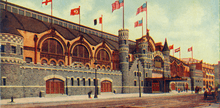
The Black Hawks played their first game on November 17, 1926, against the Toronto St. Patricks in the Chicago Coliseum. The Black Hawks won their first game 4–1, in front of a crowd of over 7,000.[5] The Hawks' first season was a moderate success; they finished the season in third place with a record of 19–22–3. However, they lost the 1927 first-round playoff series to the Boston Bruins.
Following the series, McLaughlin fired head coach Pete Muldoon. According to Jim Coleman, sportswriter for the Toronto-based The Globe and Mail, McLaughlin felt the Hawks were good enough to finish first. Muldoon disagreed, and in a fit of pique, McLaughlin fired him. According to Coleman, Muldoon responded by yelling, "Fire me, Major, and you'll never finish first. I'll put a curse on this team that will hoodoo it until the end of time." The Curse of Muldoon was born – although Coleman admitted years after the fact that he had fabricated the whole incident[8] – and became one of the first widely known sports "curses." While the team would go on to win three Stanley Cups in its first 39 years of existence, it did so without ever having finished in first place, either in a single- or multi-division format. The Black Hawks proceeded to have the worst record in the league in 1927–28, winning only seven of 44 games.
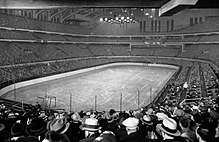
For the 1928–29 season, the Black Hawks were originally slated to play in the new Chicago Stadium, but due to construction delays and a dispute between McLaughlin and Chicago Stadium promoter Paddy Harmon, they instead divided their time between the Coliseum, the Detroit Olympia, and the Peace Bridge Arena in Fort Erie, Ontario. They moved to Chicago Stadium the following season.
By 1931, with goal-scorer Johnny Gottselig, Cy Wentworth on defense, and Charlie Gardiner in goal, the Hawks reached their first Stanley Cup Final, but fizzled in the final two games against the Montreal Canadiens. Chicago had another stellar season in 1932, but that did not translate into playoff success. However, two years later, Gardiner led his team to victory by shutting out the Detroit Red Wings in the final game of the Stanley Cup Finals; Mush March scored the winning goal in double-overtime as the Hawks beat Detroit 1-0.
In 1938, the Black Hawks had a record of 14–25–9, almost missing the playoffs. They stunned the Canadiens and New York Americans on overtime goals in the deciding games of both semi-final series, advancing to the 1938 Stanley Cup Finals against the Toronto Maple Leafs. Black Hawks goaltender Mike Karakas was injured and could not play, forcing a desperate Chicago team to pull minor-leaguer Alfie Moore out of a Toronto bar and onto the ice. Moore played one game and won it. Toronto refused to let Moore play the next, so Chicago used Paul Goodman in Game 2 and lost. However, for the third and fourth games, Karakas was fitted with a special skate to protect his injured toe, and the team won both games. It was too late for Toronto, as the Hawks won their second championship. As of 2019, the 1938 Black Hawks possess the poorest regular-season record of any Stanley Cup champion.
The Black Hawks next returned to the Finals in 1944 behind Doug Bentley's 38 goals, with Bentley's linemate Clint Smith leading the team in assists. After upsetting the Red Wings in the semi-finals, they were promptly dispatched by the dominant Canadiens in four games.
The Norris era (1944–1966)
Owner and founder Frederic McLaughlin died in December 1944. His estate sold the team to a syndicate headed by long-time team president Bill Tobin. However, Tobin was only a puppet for James E. Norris, who owned the rival Detroit Red Wings. Norris had also been the Black Hawks' landlord since his 1936 purchase of Chicago Stadium. For the next eight years, the Norris-Tobin ownership, as a rule, paid almost no attention to the Black Hawks. Nearly every trade made between Detroit and Chicago ended up being Red Wing heists. As a result, for the next several years, Chicago was the model of futility in the NHL. Between 1945 and 1958, they only made the playoffs twice.
Upon Norris' death, his eldest son, James D. Norris, and Red Wings minority owner Arthur Wirtz (the senior Norris' original partner in buying the Red Wings 23 years earlier) took over the floundering club. They guided it through financial reverses, and rebuilt the team from there. One of their first moves was to hire former Detroit coach and general manager Tommy Ivan as general manager.
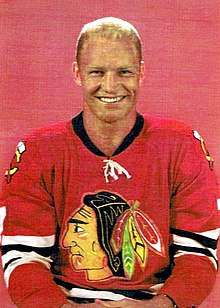
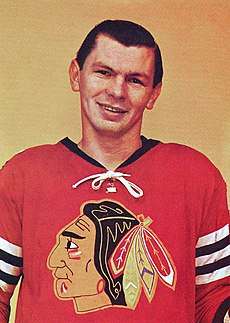
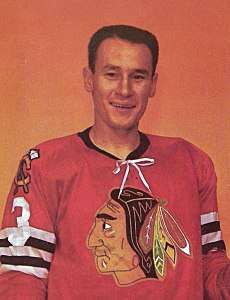
In the late 1950s, the Hawks struck gold, acquiring three young prospects (forwards Bobby Hull and Stan Mikita and defenseman Pierre Pilote), as well as obtaining both star goaltender Glenn Hall and veteran forward Ted Lindsay (who had just had a career season with 30 goals and 55 assists) from Detroit. Hull, Mikita, Pilote and Hall became preeminent stars in Chicago, and all four would eventually be inducted into the Hockey Hall of Fame.
After two first-round exits at the hands of the eventual champions from Montreal in 1959 and 1960, it was expected the Canadiens would once again defeat the Hawks when they met in the semi-finals in 1961. A defensive plan that completely wore down Montreal's superstars worked, however, as Chicago won the series in six games. They then bested the Wings to win their third Stanley Cup championship.

The Hawks made the Cup Finals twice more in the 1960s, losing to the Leafs in 1962 and the Canadiens in 1965. They remained a force to be reckoned with throughout the decade, with Hull enjoying four 50-goal seasons, Mikita winning back-to-back scoring titles and MVP accolades, Pilote winning three consecutive Norris Trophies, and Hall being named the First or Second All-Star goaltender eight out of nine seasons. Hull and Mikita especially were widely regarded as the most feared one-two punch in the league. However, despite a strong supporting cast which included Bill Hay, Ken Wharram, Phil Esposito, Moose Vasko, Doug Mohns and Pat Stapleton, the Hawks never quite put it all together.
In 1966–67, the last season of the six-team NHL, the Black Hawks finished first, breaking the supposed "Curse of Muldoon", 23 years after the death of Frederic McLaughlin. However, they lost in the semi-finals to Toronto, who went on to win their last Stanley Cup of the era. Afterward, Coleman, who first printed the story of the curse in 1943, admitted that he made the story up to break a writer's block he had as a column deadline approached.
The Arthur Wirtz era (1966–1983)
James D. Norris died in 1966. One of his last moves in the NHL was to arrange an expansion franchise in St. Louis, where he owned the St. Louis Arena. Tobin died in 1963, a club vice-president until his death. Ownership now passed to Norris' longtime partner, Arthur Wirtz, and his son Bill Wirtz. The Wirtz–Norris partnership dated over three decades; Arthur Wirtz had been a minority partner in the syndicate the senior Norris put together to buy the Red Wings in 1932.
Goaltender Glenn Hall was drafted by the expansion St. Louis Blues for the 1967–68 season, while Pierre Pilote was traded to the Maple Leafs in exchange for Jim Pappin in 1968. In the 1968–69 season, despite Bobby Hull breaking his own previous record of 54 goals in a season with 58, the Black Hawks missed the playoffs for the first time since 1958, and the last time before 1997–98.
In 1967, the Black Hawks made a trade with the Boston Bruins that turned out to be one of the most one-sided in the history of the sport. Chicago sent young forwards Phil Esposito, Ken Hodge and Fred Stanfield to Boston in exchange for Pit Martin, Jack Norris and Gilles Marotte. While Martin would star for the Hawks for many seasons, Esposito, Hodge and Stanfield would lead the Bruins to the top of the NHL for several years and capture two Stanley Cups. In Boston, Esposito set numerous scoring records en route to a career as one of the NHL's all-time greats.
Nonetheless, in the 1970–71 season, life was made easier for Chicago, as in an attempt to better balance the divisions, the expansion Buffalo Sabres and Vancouver Canucks were both placed in the East Division while the Hawks moved into the West Division. They became the class of the West overnight, rampaging to a 46–17–15 record and an easy first-place finish. With second-year goalie Tony Esposito (Phil's younger brother and winner of the Calder Memorial Trophy for Rookie of the Year the previous season), Hull, his younger brother Dennis, Mikita and sterling defensemen Stapleton, Keith Magnuson and Bill White, the Hawks reached the Stanley Cup Final, losing to the Canadiens.
A critical blow to the franchise came in 1972–73, though, with the start of the World Hockey Association (WHA). Long dissatisfied with how little he was paid as the NHL's marquee star, Bobby Hull jumped to the upstart Winnipeg Jets for a million-dollar contract. Former Philadelphia Flyers star Andre Lacroix, who received very little ice time in his single season in Chicago, joined Hull, and the pair became two of the WHA's great stars. However, the Hawks repeated their appearance in the Stanley Cup Final that year, again losing to Montreal. Stapleton also left for the WHA after that year, depleting the team further.
While the team led or was second in the West Division for four straight seasons, for the rest of the 1970s, the Black Hawks made the playoffs each year—winning seven division championships in the decade in all—but were never a successful Stanley Cup contender, losing 16-straight playoff games at one point. The team acquired legendary blueliner Bobby Orr from the Boston Bruins in 1976, but ill health forced him to sit out for most of the season, and he eventually retired in 1979, having played only 26 games for the Hawks. Stan Mikita did the same the following year after playing 22 years in Chicago, the third-longest career for a single team in league history.
By 1982, the Black Hawks squeaked into the playoffs as the fourth seed in the Norris Division (at the time the top four teams in each division automatically made the playoffs), and were one of the NHL's Cinderella teams that year. Led by second-year Denis Savard's 32 goals and 119 points and Doug Wilson's 39 goals, the Hawks stunned the Minnesota North Stars and St. Louis Blues in the playoffs before losing to another surprise team, the Vancouver Canucks, who made the Stanley Cup Finals. Chicago proved they were no fluke the next season, also making the third round before losing to the eventual runner-up Edmonton Oilers. After an off-year in 1984, the Hawks again faced a now fresh-off-a-ring Edmonton offensive juggernaut of a team and lost in the third round in 1985.
The Bill Wirtz era (1983–2007)
In 1983, Arthur Wirtz died and the club came under the sole control of his son Bill Wirtz. Although the Black Hawks continued to make the playoffs each season, the club began a slow decline, punctuated with an appearance in the 1992 Stanley Cup Finals.
During the 1985 playoff series against Edmonton, the Black Hawks and their fans started a tradition of cheering during the singing of "The Star-Spangled Banner".[9]
Moreover, prior to the 1986–87 season, while going through the team's records, someone discovered the team's original NHL contract and found that the name "Blackhawks" was printed as a compound word as opposed to two separate words, "Black Hawks", which was the way most sources had been printing it for 60 years and as the team had always officially listed it. The name officially became "Chicago Blackhawks" from that point on.[10]
In the late 1980s, Chicago still made the playoffs on an annual basis but made early-round exits each time.
In 1988–89, after three-straight first-round defeats, and despite a fourth-place finish in their division in the regular season, Chicago made it to the Conference Final in the rookie seasons of both goalie Ed Belfour and center Jeremy Roenick. However, once again they would fail to make the Stanley Cup Final, losing to the eventual champions Calgary Flames.
The following season, the Hawks did prove they were late-round playoff material, running away with the Norris Division title, but, yet again, the third round continued to stymie them, this time against the eventual champion Oilers, despite 1970s Soviet star goaltender Vladislav Tretiak coming to Chicago to become the Blackhawks' goaltender coach.
In 1990–91, Chicago was poised to fare even better in the playoffs, winning the Presidents' Trophy for best regular-season record, but the Minnesota North Stars stunned them in six games in the first round en route to an improbable Stanley Cup Final appearance.
In 1991–92 the Blackhawks – with Roenick scoring 53 goals, Steve Larmer scoring 29 goals, Chris Chelios (acquired from Montreal two years previously) on defense, and Belfour in goal – finally reached the Final after 19 years out of such status. The Blackhawks won 11 consecutive playoff games that year, which set an NHL record. However, they were swept four games to none by the Mario Lemieux-led defending Stanley Cup champion Pittsburgh Penguins (who, in sweeping the Blackhawks, tied the record Chicago had set only days before). Although the 4–0 sweep indicates Pittsburgh's dominance in games won, it was actually a close series that could have gone either way. Game 1 saw the Blackhawks squander leads of 3–0 and 4–1, and would eventually be beaten 5–4 after a Lemieux power-play goal with 9 seconds remaining in regulation. The Blackhawks most lackluster game was game two, losing 3–1. A frustrating loss of 1–0 followed in game three, and a natural hat trick from Dirk Graham and stellar play from Dominik Hasek (who showed indications of the goaltender he would later become) could not secure a win in game four, which ended in a 6–5 final in favor of Pittsburgh. The defending NBA champion Chicago Bulls were in their finals in 1992, but won their championship in six. This was the only year the city of Chicago would host a concurrent NBA/NHL finals in the same year, Blackhawks head coach Mike Keenan would see this again in New York when he coached the Rangers to their first Stanley Cup in 54 years in 1994.
Belfour posted a 40-win season in 1992–93 as the Hawks looked to go deep yet again, and Chelios accumulated career-high penalty time with 282 minutes in the box, but St. Louis stunned Chicago with a first-round sweep to continue Chicago's playoff losing streak.
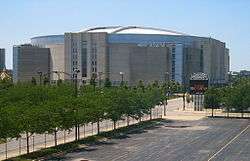
Although they finished near .500 in 1994, the Blackhawks again qualified for the playoffs. They were eliminated by eventual Western Conference finalist Toronto, but broke their playoff losing streak at 10 games with a game three win. It wasn't enough, however, and the Blackhawks fell in six games. The 1993–94 season also marked the Blackhawks' last at the old Chicago Stadium, and the team moved into the new United Center in the lockout-shortened 1995 season. Bernie Nicholls and Joe Murphy both scored 20 goals over 48 games, and Chicago once again made it to the Western Conference Final, losing to the rival Detroit Red Wings. Also in 1994, management fired Wayne Messmer, popular singer of "The Star-Spangled Banner".
Roenick, Belfour and Chelios were all traded away as the Blackhawks faltered through the late 1990s until they missed the playoffs by five points in 1998 for the first time in 29 years, one season short of tying the Boston Bruins' record for the longest such streak in North American professional sports history. Chicago would also miss the playoffs for a second consecutive season in 1999, and missed the playoffs again in 2000 and 2001.
The millennium started with disappointment for the Blackhawks. Éric Daze, Alexei Zhamnov and Tony Amonte emerged as some of the team's leading stars by this time. However, aside from a quick first-round exit in 2002 (where they lost to the St. Louis Blues in five games after winning Game 1 of the series), the Hawks were consistently out of the playoffs from the 1997–98 season until the 2008–09 season, in most years finishing well out of contention, despite finishing in third place in the Central Division six times. Amonte left for the Phoenix Coyotes in the summer of 2002.
During the 2002–03 season, the Blackhawks finished third in the Central Division with 79 points, but would finish ninth in the Western Conference, which would make them miss the playoffs by 13 points.
A somber note was struck in February 2004 when ESPN named the Blackhawks the worst franchise in professional sports.[11] Indeed, the Blackhawks were viewed with much indifference by Chicagoans for much of the 1990s and early 2000s due to anger over several policies instituted by then-owner Bill Wirtz, who was derisively known as "Dollar Bill". For example, Wirtz did not allow home games to be televised in the Chicago area, claiming it was unfair to the team's season ticket holders. He also raised ticket prices to an average of $50, among the most expensive in the NHL. The Chicago Wolves, an American Hockey League (AHL) team based in Rosemont, Illinois, mocked the Blackhawks' struggle by creating a marketing slogan, "We Play Hockey The Old-Fashioned Way: We Actually Win."[12]
Following the lockout of the 2004–05 season, new general manager Dale Tallon set about restructuring the team in the hopes of making a playoff run. Tallon made several moves in the summer of 2005, most notably the signing of Tampa Bay Lightning Stanley Cup-winning goaltender Nikolai Khabibulin and All-Star defenseman Adrian Aucoin. However, injuries plagued Khabibulin and Aucoin, among others, and the Blackhawks again finished well out of the playoffs with a 26–43–13 record – next-to-last in the Western Conference, and the second-worst in the NHL.
The Blackhawks reached another low point on May 16, 2006, when they announced that popular TV/radio play-by-play announcer Pat Foley was not going to be brought back after 25 years with the team, a move unpopular amongst most Blackhawks fans. Foley then became the television/radio voice of the Chicago Wolves.
With the third overall pick in the 2006 NHL Entry Draft, the team selected Jonathan Toews, who led the University of North Dakota Fighting Sioux hockey team to the 2006 NCAA Frozen Four.
The Blackhawks were eager to make a splash in the free-agent market and offered big money to many of the top free agents. However, they were denied, only being able to acquire two backup goaltenders in Patrick Lalime and Sebastien Caron. Chicago was one of the biggest buyers in the trade market, acquiring a future franchise player in left-winger Martin Havlat, as well as center Bryan Smolinski from the Ottawa Senators in a three-way trade that also involved the San Jose Sharks. The Hawks dealt forward Mark Bell to the Sharks, Michal Barinka and a 2008 second-round draft pick to the Senators, while Ottawa also received defenseman Tom Preissing and center Josh Hennessy from San Jose. Havlat gave the Blackhawks the talented, first-line caliber game breaker they so desperately needed. The Havlat trade was soon followed by another major trade – winger and key Blackhawk player Kyle Calder was traded to the Philadelphia Flyers in exchange for grinding defensive center Michal Handzus. The move caused a stir in Chicago; Calder had won an increase in his contract through arbitration, which was accepted by the Hawks, but rather than ink their leading scorer, the Blackhawks decided to address their need for a proven center by acquiring Handzus. Injuries to both Havlat and Handzus hurt the Blackhawks, and Smolinski was eventually traded at the trade deadline to the Vancouver Canucks. On November 26, 2006, Blackhawks general manager Dale Tallon fired head coach Trent Yawney and appointed assistant coach Denis Savard as the head coach. Savard had been the assistant coach of the Blackhawks since 1997, the year after he retired as one of the most popular and successful Blackhawks players of all time. The Blackhawks continued to struggle, and finished last in the Central Division, 12 points out of the playoffs.
They finished with the fourth worst record in the NHL, and in the Draft Lottery, won the opportunity to select first overall in the draft. The team had never had a draft pick higher than third overall before, and used the pick to draft right wing Patrick Kane from the London Knights of the Ontario Hockey League (OHL).
The Rocky Wirtz era (2007–present)
2007–2009: Rebuilding
On September 26, 2007, Bill Wirtz, the longtime owner of the Blackhawks, died after a brief battle with cancer.[13] He was succeeded by his son, Rocky, who drastically altered his father's long-standing policies.[14]
Midway into the 2007–08 NHL season, the franchise experimented with a partnership with Comcast SportsNet Chicago and WGN-TV by airing selected Blackhawks home games on television.[15] During the next season, Comcast and WGN began airing all of the team's regular season games.[15] Rocky also named John McDonough, formerly the president of Major League Baseball's Chicago Cubs, as the franchise's new president.[16] Since taking over the position, McDonough has been an instrumental figure in the Blackhawks current marketing success.[17] Wirtz was also able to bring back former Blackhawks greats Tony Esposito, Stan Mikita and Bobby Hull as the franchise's "hockey ambassadors".[18]
In addition to the changes in the team's policies and front office, the younger Wirtz also made a concerted effort to rebuild the team.[19] The Blackhawks roster was bolstered by the addition of Patrick Kane, the first overall selection in the 2007 NHL Entry Draft, who led all rookies in points.[20] Kane and Jonathan Toews were finalists for the Calder Memorial Trophy, awarded to the NHL's best rookie. Kane ultimately beat his teammate for the award.[21] Kane finished the 2007–08 season with 21 goals and 51 assists in 82 games. The Blackhawks finished with a record of 40–34–8, missing the playoffs by three points. The 2007–08 season marked the first time in six years that the team finished above .500.[22]
Prior to the 2008–09 season opener, the Blackhawks named Toews, at 20 years and 79 days, as the new captain, succeeding the traded Lapointe and making him the third-youngest captain at the time of appointment. In addition to a new captain, the Blackhawks made several major roster changes before the 2008–09 NHL season. The team traded Tuomo Ruutu, their longest tenured player, to the Carolina Hurricanes in exchange for forward Andrew Ladd on February 26, 2008.[23] Later that day, the Blackhawks traded captain Martin Lapointe to the Ottawa Senators in exchange for a sixth-round draft pick in the 2008 NHL Entry Draft.[23] On the first day of free agency, July 1, the team signed goaltender Cristobal Huet to a four-year, US$22.5 million contract, and later signed defenseman Brian Campbell to an eight-year, $56.8 million contract.[24] The team also added former coaches Joel Quenneville and Scotty Bowman to their organization.[25][26][27]
On February 13, 2008, the Blackhawks announced they would hold their first fan convention. On July 16, 2008, the team announced that they would host the 2009 NHL Winter Classic on a temporary ice rink at Wrigley Field on New Year's Day against fellow "Original Six" members, the Detroit Red Wings.[28] The Red Wings defeated Chicago 6–4. On June 16, Pat Foley returned as the Blackhawks' TV play-by-play man, replacing Dan Kelly. Foley called Blackhawks games from 1981 to 2006 and spent the next two years broadcasting for the Chicago Wolves. Foley was partnered with Eddie Olczyk to broadcast all of the Blackhawks' games.[29][30] On October 16, 2008, the Blackhawks relieved Denis Savard of his head coaching duties and replaced him with Joel Quenneville.[31] Savard has since been brought back to the organization as an ambassador.
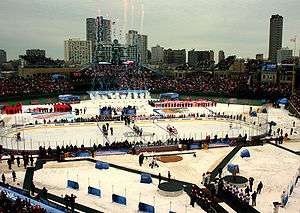
The Blackhawks finished the 2008–09 regular season in second place in their division with a record of 46–24–12, putting them in fourth place in the Western Conference with 104 points. The Blackhawks clinched a playoff berth for the first time since the 2001–02 season with a 3–1 win over Nashville on April 3. On April 8, with a shootout loss to the Columbus Blue Jackets, the Blackhawks clinched their first 100-point season in 17 years. The Blackhawks defeated the fifth-seeded Calgary Flames in six games to advance to the Western Conference Semifinals for the first time since 1996.[32] The team proceeded to defeat the third-seeded Vancouver Canucks in six games.[33] The Blackhawks played the then-Stanley Cup champion Detroit Red Wings for the Western Conference Championship, losing the series in five games.[34]
During the 2008–09 season, the team led the NHL in home attendance with a total of 912,155 spectators, averaging 22,247 per game.[35] This figure includes the 40,818 fans from the Winter Classic at Wrigley Field. Therefore, the total attendance for games hosted at the United Center is 871,337, good for an average of 21,783 which still led the NHL over Montreal's 21,273 average. The Blackhawks welcomed their one millionth fan of the season at the United Center before Game 6 of the Western Conference Semifinals on May 11, 2009.[36]
2009–10: The Stanley Cup returns to Chicago

Prior to the 2009–10 NHL season, the Blackhawks made another major free agent purchase, signing Marian Hossa to a 12-year, US$62.8 million contract.[37] The team also acquired Tomas Kopecky, John Madden and Richard Petiot.[37][38] In early July, general manager Dale Tallon and the Blackhawks management came under fire when the National Hockey League Players' Association (NHLPA) claimed the team did not submit offers to their restricted free agents before the deadline.[39] In the worst-case scenario, the team's unsigned restricted free agents at the time, including Calder Memorial Trophy finalist Kris Versteeg, would have become unrestricted free agents.[39] Despite the ordeal, the Blackhawks were able to sign Versteeg and all of their restricted free agents before the NHLPA could take further action.[39] On July 14, 2009, the Blackhawks demoted Tallon to the position of senior adviser. Stan Bowman, son of Scotty Bowman, was promoted to general manager.[40] The Blackhawks continued to sell-out games, with the best average attendance of 21,356 over Montreal's 21,273 in the NHL, and had a total of 854,267, excluding the playoffs. The Blackhawks reached the one million mark in Game 3 of the Western Conference Finals against the San Jose Sharks.
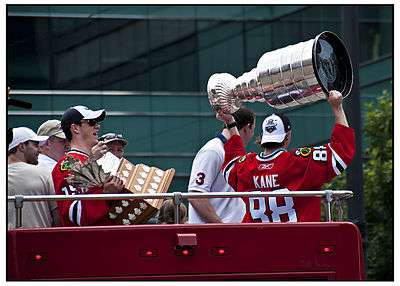
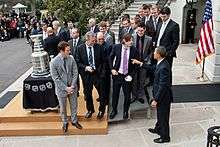
The Blackhawks re-signed Patrick Kane and Jonathan Toews to contract extensions worth $31.5 million over five years, and Duncan Keith to a 13-year extension worth $72 million on December 1, 2009. On April 6, 2010, the Hawks won their 50th game of the 2009–10 season against the Dallas Stars, setting a new franchise record for wins in a season. The next night, April 7, the Hawks notched their 109th point of the season against the St. Louis Blues, setting another franchise record.
The Blackhawks made the playoffs for the second consecutive season with a regular-season record of 52–22–8. They defeated the Nashville Predators in six games in the first round, before defeating the third-seeded Vancouver Canucks for the second straight year, again in six games. The Blackhawks then swept the top-seeded San Jose Sharks in the Western Conference Finals. The team advanced to the Stanley Cup Finals for the first time since 1992, where they played the Philadelphia Flyers. The Blackhawks prevailed in six games to secure their fourth Stanley Cup in franchise history. The victory also ended the team's 49-year championship drought.[41]
2010–2012
The Blackhawks immediately faced salary cap constraints prior to the 2010–11 NHL season. The team was forced to trade many players who played an integral role to their 2009–10 Stanley Cup victory, including Dustin Byfuglien, Andrew Ladd, Kris Versteeg, Brent Sopel, Ben Eager and Colin Fraser.[42] The team was also unable to agree to terms with starting goaltender Antti Niemi, who left as restricted free agent to the San Jose Sharks.[43] The Blackhawks signed former Dallas Stars starting goalie Marty Turco as his replacement, but eventually turned to rookie Corey Crawford to become their full-time starting goaltender.[44] The Blackhawks also made a mid-season trade to acquire winger Michael Frolik from the Florida Panthers in exchange for Jack Skille, Hugh Jessiman and David Pacan.[45]
Amidst the roster turnaround, the Blackhawks finished the season with a 44–29–9 record and placed third in the Central Division and eighth in the Western Conference. The team's playoff fate was determined on the final day of the regular season.[46] The Blackhawks lost their regular season finale to the Detroit Red Wings, but received the final seed in the Western Conference after the Minnesota Wild defeated the Dallas Stars.[46] In the first round of the 2011 playoffs, the Blackhawks faced the top-seeded Vancouver Canucks, which marked the third consecutive post-season the two teams faced each other.[47] The Canucks built a three-game lead in the series before the Blackhawks were able to win three games in a row.[47] Alex Burrows won Game 7 for the Canucks in overtime, 2–1.[47]
Before the 2011–12 season, the Blackhawks continued to make roster moves to optimize their salary cap situation. The team traded Troy Brouwer to the Washington Capitals in exchange for the 26th overall pick in the 2011 NHL Entry Draft (used to select Phillip Danault). The Blackhawks also traded defenseman Brian Campbell, who had one of the richest contracts in the franchise's history, to the Florida Panthers.[48] The team bolstered their forward depth by signing veterans Daniel Carcillo, Jamal Mayers and Andrew Brunette,[49] while also acquiring goaltender Ray Emery to back-up Corey Crawford.[50] The Blackhawks called-up prospects Brandon Saad, Andrew Shaw, Nick Leddy and Marcus Kruger, who became regular starters.[51]
The Blackhawks placed fourth in the Central Division with a 45–26–11 record and qualified for the playoffs for a fourth consecutive season.[52] They faced the Phoenix Coyotes in the opening round, who eliminated the Blackhawks in six games. The series saw five of the six games going to overtime, with Bryan Bickell (Game 2) and Jonathan Toews (Game 5) scoring the only Blackhawk overtime winners of the series.[53]
2012–13: Presidents' Trophy and fifth Stanley Cup
The Blackhawks started the lockout-shortened 2012–13 season with much success by establishing several new franchise and NHL records. On January 27, 2013, the Blackhawks set a new franchise record for starting the season 6–0–0 after a win against the Detroit Red Wings.[54] On February 19, the Blackhawks tied the NHL record previously set by the Anaheim Ducks in the 2006–07 season for earning points in the first 16 consecutive games of a season, and beat the Ducks record (28 points) by one point.[55] On March 6, the Blackhawks extended the NHL record to 24 games with a record of 21–0–3, and the franchise record for most consecutive wins to 11 games.[56] However, the Blackhawks lost 6–2 to the Colorado Avalanche on March 8.[56] It was their first loss in regulation and ended their 24-game streak in which they earned at least one point, an NHL record to start a season.[56] The point streak was the third-longest in NHL history.[57][58][59]
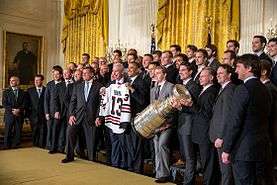
The United Center also recorded its 200th consecutive combined regular season and playoff Blackhawks sell-out on March 1 against the Columbus Blue Jackets, which began during the 2007–08 season with the game on March 30, 2008, against the Blue Jackets.[60] The Blackhawks won the 2012–13 Presidents' Trophy for the best regular season record in the NHL and clinched home-ice advantage throughout the playoffs.[61] After dispatching the Minnesota Wild in the first round, the Blackhawks faced the Detroit Red Wings in the Western Conference Semifinals. The Blackhawks won the series opener but lost the next three games and faced elimination. However, the Blackhawks clawed back into the series, eventually winning the series on a goal by Brent Seabrook in overtime of Game 7.[62] The team then defeated the Los Angeles Kings in five games to secure a second Stanley Cup Final appearance in four seasons.[63]
The Blackhawks faced the Boston Bruins, another Original Six team, in the 2013 Stanley Cup Finals.[64] It was the first time since 1979 that two Original Six teams had made the Stanley Cup Finals and the first time since 1945 that the last four teams to win the Stanley Cup were in the Conference Finals.[64] The Bruins made their second appearance in the Finals in three years (winning in 2011) and were making a similar resurgence as the Blackhawks. On June 24, the Blackhawks defeated the Bruins in the sixth game of the series to win the Stanley Cup, having overcome a 2–1 deficit with just over a minute remaining in the game.[61] Bryan Bickell and Dave Bolland scored goals with 1:16 and 0:58.3 remaining in the game, just 17 seconds apart, to win 3–2.[61]
2013–14
The Blackhawks began the 2013–14 season in hopes of becoming the first team to win consecutive Stanley Cups since the Detroit Red Wings in 1997 and 1998.[65] The team was dramatically altered in the off-season to remain under the salary cap.[66] The team traded Dave Bolland, Daniel Carcillo and Michael Frolik in exchange for future draft picks, while parting ways with Ray Emery and Viktor Stalberg.[67] Despite these changes, the Blackhawks tallied a 28–7–7 record going into January 2014. The team played their second outdoor game in franchise history, against the Pittsburgh Penguins at Soldier Field, as part of the 2014 NHL Stadium Series. The Blackhawks defeated the Penguins 5–1 in front of 62,921 fans.[68]
The franchise recorded its 2,500th regular season win, while head coach Joel Quenneville won 693 wins as a coach, the third most in the history of the NHL.[69][70] The Blackhawks finished the season with a 46–21–15 record, good for third in the Central Division. They opened the playoffs by losing two games to the St. Louis Blues. The Blackhawks surged back with four straight wins to take the series.[71] The team then defeated the Minnesota Wild for the second consecutive year. However, the Los Angeles Kings defeated the Blackhawks in seven games and ultimately went on to win the Stanley Cup.[72] After the season's conclusion, Duncan Keith won the James Norris Memorial Trophy for the second time in his career, and Jonathan Toews was named a finalist for the Frank J. Selke Trophy.[73][74]
2014–15: Sixth Stanley Cup
The Blackhawks' roster remained largely intact following the 2013–14 season. The team signed veteran center Brad Richards and rookie goaltender Scott Darling to one-year contracts, and traded defenseman Nick Leddy to the New York Islanders in exchange for three prospects.[75][76][77] For the first half of the season, Patrick Kane led the team in scoring and points. The Blackhawks mustered a 30–15–2 record going into the All-Star break.[78] The Blackhawks sent six players to the All-Star Game, including Kane, Jonathan Toews, Duncan Keith, Brent Seabrook and Corey Crawford.[79] The team also played in the 2015 NHL Winter Classic at Nationals Park in Washington, D.C., where they lost 3–2 to the Washington Capitals.[80]
However, in late February, Kane suffered a shoulder injury that was expected to sideline him for the remainder of the regular season and much of the playoffs.[81] The team called-up rookie Teuvo Teravainen from the AHL and traded their first-round pick in the 2015 NHL Entry Draft to acquire center Antoine Vermette from the Arizona Coyotes.[82] The Blackhawks also acquired veteran defenseman Kimmo Timonen from the Philadelphia Flyers for second round picks in 2015 and 2016,[83] and Andrew Desjardins from the San Jose Sharks in exchange for Ben Smith.[84] The Blackhawks finished the season with a 48–28–6 record, placing third in their division. The team allowed the fewest goals in the NHL.[85]
Kane recovered quicker than projected and was ready for the start of the playoffs.[86] The Blackhawks dispatched the Nashville Predators in six games and swept the Minnesota Wild to advance to the Western Conference Finals for the fifth time in seven years.[87] The top-seeded Anaheim Ducks held a 3–2 lead in the series, but the Blackhawks rallied back in the series to win games six and seven. The team then defeated the Tampa Bay Lightning in the 2015 Stanley Cup Finals to secure their third Stanley Cup in six seasons.[88]
2015–present
The Blackhawks' roster experienced another dramatic reconstruction before the 2015–16 season. The team was unable to come to terms with pending free agent Brandon Saad, who had played a pivotal role in the 2015 playoffs.[89] The Blackhawks traded Saad's negotiation rights (along with prospects Alex Broadhurst and Michael Paliotta) to the Columbus Blue Jackets in exchange for Artem Anisimov, Marko Dano, Corey Tropp, Jeremy Morin and a fourth-round draft pick in the 2016 NHL Entry Draft.[90] The Blackhawks were unable to re-sign unrestricted free agents Brad Richards, Antoine Vermette and Johnny Oduya due to salary cap constraints.[91] The team then traded long-time veteran and fan-favorite Patrick Sharp (along with Stephen Johns) to the Dallas Stars in exchange for Trevor Daley and forward Ryan Garbutt in order to stay under the salary cap.[92] Amidst the roster turnover, the Blackhawks signed free agent Artemi Panarin from the Kontinental Hockey League (KHL) to an entry-level contract.[93]
The Blackhawks offense was led by Patrick Kane, who scored an NHL-best 106 points in 2015–16 and also won the season's Hart Memorial Trophy as league MVP.[94] Panarin, who skated on Kane's line, won the Calder Memorial Trophy, awarded to the NHL's best first-year player.[95] Midway through the season, the Blackhawks attempted to supplement their roster by making several trades. The Blackhawks dealt Jeremy Morin to the Toronto Maple Leafs in exchange for Richard Panik.[96] The team then reacquired Andrew Ladd from the Winnipeg Jets in exchange for their first round selection in the 2016 NHL Entry Draft and Marko Dano.[97] The team then traded Phillip Danault and their 2018 second round pick to the Montreal Canadiens in exchange for forwards Dale Weise and Tomas Fleischmann.[98] The team finished with a 46-26-9 record, good for 103 points and third place in their division. The Blackhawks were defeated by the St. Louis Blues in a seven-game series in the first round of the 2016 playoffs.[99] The loss marked the Blackhawks earliest playoff exit since 2012.[100]
Salary cap constraints forced the Blackhawks to make additional trades before the 2016–17 season. The team traded pending free-agent Andrew Shaw to Montreal in exchange for two second-round 2016 draft picks.[101] The Blackhawks also traded Bryan Bickell and Teuvo Teravaainen to the Carolina Hurricanes in exchange for another 2016 second-round pick in order to free additional salary cap space.[102] The Blackhawks signed veteran Brian Campbell and KHL stand-out Michal Kempny during free agency.[103][104] The team then turned to their farm system to replenish their depth. The Blackhawks promoted rookies Ryan Hartman, Gustav Forsling, Tyler Motte, Nick Schmaltz and Vinnie Hinostroza to their starting line-up to fill the vacancies left by Shaw, Bickell and Teravainen.[105]
Patrick Kane spearheaded the Blackhawks offense with 34 goals and 55 assists, tying for second in scoring during the regular season among all skaters.[106] He was aided by his linemate, Panarin, who scored 31 goals and 43 assists.[106] In addition to Kane and Panarin, Jonathan Toews, Marian Hossa, Artem Anisimov and Richard Panik all scored at least 20 goals.[107] Toews, Kane, Duncan Keith and Corey Crawford were also selected to play in the All-Star Game.[108] The Blackhawks finished the season with 109 points, placing first in the Central Division and earning the top-seed in the Western Conference for the 2017 playoffs.[106] However, they were swept in the first round by the eighth-seeded Nashville Predators in one of the biggest upsets in NHL playoff history; this was the first time that an eighth seed swept a playoff series against the top team in the conference.[109] Goaltender Pekka Rinne and the Predators' defense marginalized the Blackhawks' offense, limiting the team to only three total goals in the series, including a pair of shutouts in Game 1 (1–0) and Game 2 (5–0) at the United Center to begin the series.[110]
Prior to the 2017–18 season, the Blackhawks revealed Marian Hossa would miss the entire 2017–18 season due to a progressive skin disorder.[111][112] The team made two major trades before the 2017 NHL Entry Draft; veteran defenseman Niklas Hjalmarsson was dealt to the Arizona Coyotes in exchange for Connor Murphy and Laurent Dauphin, while Artemi Panarin was traded to the Columbus Blue Jackets to reacquire Brandon Saad in a four-player deal.[113] Both Hjalmarsson and Hossa were core members of the Blackhawks roster that won three Stanley Cups in 2010, 2013 and 2015.[113] The team also traded goaltender Scott Darling to the Carolina Hurricanes and center Marcus Kruger to the Vegas Golden Knights, while also lost defensemen Trevor van Riemsdyk to the Golden Knights in the 2017 NHL Expansion Draft and Brian Campbell, who retired.[114] The Blackhawks acquired wingers Patrick Sharp, Tommy Wingels and Lance Bouma in free agency.[114]
The Blackhawks opened the 2017–18 season with a resounding 10–1 victory over the Pittsburgh Penguins.[115] The Blackhawks were four games above .500 with an 18–14–6 record at the end of December 2017, and only four points out of a playoff spot.[116] However, goaltender Corey Crawford missed much of 2018 due to an upper-body injury.[117] Inconsistent defense and goaltending, coupled with limited offense, resulted in the team falling to the bottom of the Central Division.[118][119] The Blackhawks were eliminated from playoff contention on March 20, 2018, marking the first time in nine years that the team failed to qualify for the Stanley Cup playoffs.[119] The team finished the season with a 33–39–10 record and 76 points in the standings.[120]
The Blackhawks made modest acquisitions during the opening day of free agency by acquiring veterans Cam Ward, Chris Kunitz and Brandon Manning.[121] The team made their biggest move of the offseason by offloading Hossa's contract onto the Arizona Coyotes by trading Vinnie Hinostroza, Jordan Oesterle and third-round draft pick in the 2019 NHL Draft in exchange for Marcus Kruger, MacKenzie Entwistle, Jordan Maletta, Andrew Campbell and a fifth-round draft pick in the 2019 NHL Draft.[122] Quenneville named Ward the team's starting goaltender as Crawford missed the first five games of the 2018–19 season with concussion-like symptoms. The Blackhawks opened the season with a promising 6–2–2 start despite Crawford's initial absence.[123] However, after losing their next five games,[123] head coach Quenneville (as well as assistant coaches Kevin Dineen and Ulf Samuelsson) were fired on November 6, 2018. Jeremy Colliton, previously the head coach of the Blackhawks' AHL affiliate, the Rockford IceHogs, was named the 38th head coach in franchise history.[124]
The team adjusted their roster by trading Nick Schmaltz to the Arizona Coyotes in exchange for Dylan Strome and Brendan Perlini.[125] The Blackhawks then dealt Brandon Manning to the Edmonton Oilers for Drake Caggiula.[126] The team struggled despite these changes and plummeted to the bottom of the NHL's standings by the All-Star break,[127] but then rebounded with an 18–10–3 record during the second half of the season, and missed playoffs by six points, while finishing in sixth place in the Central Division.[128] After missing the playoffs for the second straight season, the Blackhawks won the third-overall pick in the 2019 NHL Entry Draft at the NHL Draft Lottery, which they used to select Kirby Dach.[129][130]
Prior to the 2019-20 season, The Blackhawks signed center Ryan Carpenter and goalie Robin Lehner on the opening day of free agency.[131] The team made three separate trades to acquire Olli Määttä, Calvin de Haan, and Alex Nylander.[132] The team reacquired fan-favorite Andrew Shaw in a trade with the Montreal Canadiens.[133] The Blackhawks also inserted rookie Dominik Kubalík into their roster, whom they acquired from the Los Angeles Kings in the previous season.[134] The Blackhawks posted a 32–30–8 record and finished last in their division before the remainder of the regular season was canceled due to the COVID-19 pandemic.[135] The team fired John McDonough, who served as the Blackhawks' president for 13 years.[136] The Blackhawks obtained a spot in the 2020 Stanley Cup playoffs, which uses a 24-team playoff format among the top 12 teams in each conference.[137] The 12th-seeded Blackhawks defeated the Edmonton Oilers in the qualifying round of the playoffs to advance to the Western Conference first round.[138]
Team information
Jerseys
The Blackhawks wear predominantly red jerseys featuring three sets of black and white stripes along the sleeves and waist.[139][140] The team's logo is displayed on the front of each jersey, along with a 'C', representing 'Chicago', on each shoulder with two crossed tomahawks.[139] The Blackhawks debuted this design in 1955, and have since only made minor modifications to the jersey.[139][140] In 2007, The Blackhawks along with all other NHL teams, made minute changes to their uniforms by adding larger logo, a new collar with the NHL logo and a 'baseball-style cut along the bottom.[141] The team previously donned alternate third jersey that was primarily black with red and white stripes between 1996 and 2007.[140][142] The Blackhawks brought this design back in 2008, before making their 2009 Winter Classic jerseys their alternates between 2009–11. The team has not used an alternate jersey home jersey since 2011.[139][140]
The Blackhawks' uniform was voted one of the 25 best in professional sports by Paul Lukas of GQ in November 2004.[143] The Hockey News voted the team's jersey as the best in the NHL.[144] Greg Wyshynski of Yahoo! Sports listed the Blackhawks home jerseys as the second best NHL jersey in the history of the NHL in 2017.[145] The Blackhawks were voted to have the best uniform in the history of the NHL in a fan-vote conducted by the NHL in 2017.[146]
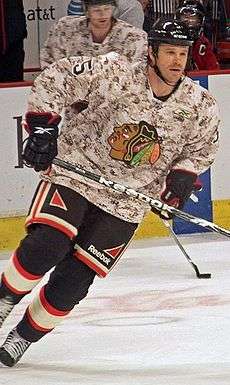
Since 2009, the Blackhawks have worn special camouflage jerseys on Veterans Day during their pregame warm-ups. The jerseys are later sold in auctions to raise money for the USO of Illinois.[147]
The Blackhawks wore jerseys based on the design worn in the 1936–37 season for the 2009 NHL Winter Classic. The jersey is predominantly black with a large beige stripe across the chest (also on the sleeves), with a red border, and an old-style circular Black Hawks logo.[148] The Blackhawks used this Winter Classic design as their third jersey for the 2009–10 season until they retired after the 2010–11 season, with the only change in the design was by adding the familiar "C" with crossed tomahawks on the shoulders.
For the 2014 NHL Stadium Series, the Blackhawks wore a black uniform similar to the alternates they wore from 1996–2009, but the stripes around the waist are no longer straight, they are jagged around the sides in order to follow the shape of the bottom of the jersey. Keeping with stripes, the ones on the arms simply stop halfway round; angled numbers are above these sleeve half-stripes. On one shoulder is the familiar "C" with crossed tomahawks logo and the Chicago 2014 Stadium Series logo on the other. Each 2014 NHL Stadium Series jerseys features chrome-treated logo designs inspired by the NHL shield. The chrome crest was developed using new technology that fuses print and embroidery and allows logos to be displayed as a high-resolution image incorporated into the crest. As a result, the design reduces the weight of the crest, creating in a lighter jersey. Numbering on the back of the jersey is enlarged and sleeve numbers are angled to improve visibility in outdoor venues.[149]
The team wore a uniform which was inspired by their 1957–58 jersey for the 2015 NHL Winter Classic. This uniform is nearly identical to the road uniform that the Blackhawks currently wear. The main differences between this design and the current road design comes in the form of the lace up collar, the name/number block font (which is serifed), and the C-Tomahawk logo, which is mostly red, black, and white (with a tad bit of yellow) instead of being mostly red, yellow, green black and white.[150]
For the 2016 NHL Stadium Series, the Blackhawks wore a unique uniform for their game against the Minnesota Wild. This uniform is primarily white with black/red/black stripes on the sleeves and socks. The current logo is on the chest. Framed between the two black stripes and over the red stripe on the sleeve is the familiar "C" with crossed tomahawks. The collar of the uniform features two different colors. The four, six-pointed red stars from the Flag of Chicago is featured on the white portion of the collar, while the other side of the collar is black. Sleeve numbers have been shifted to the shoulders and enlarged. With the shoulders being black, the numbering is white. But, the numbering and lettering on the back is also enlarged and black in color.[151]
For the 2017 NHL Winter Classic, the Blackhawks wore uniforms very similar to what they wore at the 2015 NHL Winter Classic. These new uniforms however feature a few modifications that were made to them. The most notable changes are to the logo and the cross tomahawks. The logo this time is the appropriate logo that the franchise used in 1957–65. But, they removed the roundel and the lettering so that just the logo itself stands out. The placement of the familiar "C" with crossed tomahawks is featured in the same position with the same striping pattern on the sleeve as the 2015 NHL Winter Classic uniform had. The only differences between the tomahawks from the 2015 NHL Winter Classic uniform and the 2017 NHL Winter Classic uniform are where the colors are placed for the tomahawk. The 2017 NHL Winter Classic patch is featured on the right shoulder.[152]
To honor the NHL's centennial year, a special anniversary logo was designed for the remainder of the 2016–17 season, which started on January 1, 2017 for all thirty teams, featuring a banner wrapped around the number 100 with the current NHL shield in the foreground. Both the banner and the number 100 are in same silver color as the NHL shield.[153] The Blackhawks wore this logo patch underneath the numbering on the right-sleeve on both the home and away jerseys. The Blackhawks debuted this patch on their home jerseys on January 5, 2017 and then they debuted the patch on the away jerseys on January 13, 2017. All home and away jerseys for all thirty teams will continue to have patches of the NHL's centennial emblem for the 2017–18 season, located above or below the numbers on their right sleeves, for at least up to the playing of the NHL 100 Classic on December 16, 2017.[154]
Adidas signed an agreement with the NHL to be the official outfitter of uniforms and licensed apparel for all teams, starting with the 2017–18 season, replacing Reebok.[155] The Reebok Edge template will now be retired in favor of the Adidas' ADIZERO template. The home and away uniforms that were debuted in the 2007–08 season remains nearly identical with the exception of the new Adidas ADIZERO template and the new collar. With the new collar, the NHL shield remains but is no longer placed on a lower layer with flaps nearby, as it's now front and center on a pentagon with a new "Chrome Flex" style.[156] The waist stripes are now curved instead of being straight across. The Adidas logo replaces the Reebok logo on the back collar.
For the entire 2018–19 season, on both the home and away uniforms, the Blackhawks are wearing memorial patches in remembrance of Stan Mikita, who died on August 7, 2018. The memorial patch features 21 in white on a black circle that is placed on the upper left corner on the front side of the uniform.[157][158]
For the 2019 NHL Winter Classic, the Blackhawks wore uniforms similar to what they wore from the 1926–27 season to the 1934–35 season. The black and white uniform features the black and white native American head logo on a black and white roundel with the wording "Blackhawks" arched on top and "Chicago" arched below. The native American head logo inside the roundel features the 1999–2000 native American head logo that they currently wear. The uniform has four white stripes on each of the shoulders, and five white stripes of varying thickness on each sleeve and around the waist. Inside the collar, we see several diagonal white lines, which is a nod to the end zone design used at Notre Dame Stadium. Mixed in between these white lines are the six years written in red, the six years the Blackhawks won the Stanley Cup. The Blackhawks won the Stanley Cup in 1934, 1938, 1961, 2010, 2013, and 2015.[159] After the 2019 NHL Winter Classic, the team announced that uniforms from the game would be worn in three home games of the 2018–19 season.[160]
For the 2019–20 NHL season, the home and away uniforms that were unveiled for the 2017-18 season remains nearly identical with the exception of the new collar designs. The new collar on the home uniform transitions from white to a solid red on the front as it comes over the shoulder, leading into the NHL logo with a red background in the center. The new collar on the away uniform transitions from red to a solid white on the front as it comes over the shoulder, leading into the NHL logo with a white background in the center.[161][162]
Logo
.png)
McLaughlin's wife, Irene Castle, designed the original version of the team's logo, which featured a crudely-drawn black and white Native head in a circle.[163] This design went through several significant changes between 1926 and 1955. During this period, seven distinct versions of the primary logo were worn on the team's uniforms. At the beginning of the 1955–56 season, the outer circle was removed and the head began to resemble the team's current primary logo. This crest and uniform went through subtle changes until the 1964–65 season; the basic logo and jersey design have remained constant ever since. In 2008, The Hockey News' staff voted the team's main logo to be the best in the NHL.[164] In 2010, sports columnist Damien Cox called on the franchise to retire the "racially insensitive" logo, saying that, "Clearly, no right-thinking person would name a team after an aboriginal figure these days any more than they would use Muslims or Africans or Chinese or any ethnic group to depict a specific sporting notion."[165] Furthermore, the National Congress of American Indians (NCAI) believes that all Native-themed logos, including that of the Blackhawks, "continue to profit from harmful stereotypes originated during a time when white superiority and segregation were common place."[166]
The Blackhawks have worked with the American Indian Center to help educate their community and fan base by sharing Native American culture and history. Scott Sypolt, executive counsel for the American Indian Center, commented on the logo and name controversy: Joe Podlasek, the executive director of the American Indian Center of Chicago, commented on their relationship, stating, "[The Hawks] are far and away ahead of everyone else in forward-thinking. What they have done is engaged the community. In the other cities (organizations) want nothing to do with native people but yet they're trying to say they respect us."[167] However, this stance is markedly different from the one taken by the American Indian Center up until recent years. In 2010, Joe Podlasek stated that, "The stance is very clear. We want the Chicago Blackhawks logo to change. For us, that's one of our grandfathers. Would you do that with your grandfather's picture? Take it and throw it on a rug? Walk on it and dance on it?"[168] John Blackhawk, Chairman of the Winnebago Tribe of Nebraska, has suggested that the change in position may be tied to contributions the team has recently begun making to the center: "We all do contributions, but we don't do it for the sake of wanting to be forgiven for something we've done that's offensive." [169]
In 2019, the American Indian Center of Chicago ended all ties to the Chicago Blackhawks Foundation, stating they will no longer affiliate "with organizations that perpetuate stereotypes through the use of "Indian" mascots." The AIC noted in its statement that they "previously held a relationship with the Chicago Blackhawks Foundation with the intention of educating the general public about American Indians and the use of logos and mascots. The AIC, along with members of the community have since decided to end this relationship" and stated that "going forward, AIC will have no professional ties with the Blackhawks, or any other organization that perpetuates harmful stereotypes."[170][171]
On July 7, 2020, the Blackhawks issued a press release to defend their team's name and logo. The team stated, "The Chicago Blackhawks name and logo symbolizes an important and historic person, Black Hawk of Illinois' Sac & Fox Nation, whose leadership and life has inspired generations of Native Americans, veterans and the public." The Blackhawks further stated they would "expand awareness" of Black Hawk and all Indigenous American contributions. The press release came after other American professional sports teams, including the Washington Redskins and Cleveland Indians, reevaluated their names and logos.[172]
Mascot
The Blackhawks mascot is Tommy Hawk, an anthropomorphic black hawk who wears the Blackhawks' four feathers on his head, along with a Blackhawks jersey and hockey pants.[173] Tommy Hawk often participates in the T-shirt toss and puck chuck at the United Center.[173] He walks around the concourse greeting fans before and during the game.[173] The team introduced Tommy Hawk in the 2001–02 season.[174] Tommy Hawk was inducted into the Mascot Hall of Fame in 2019.[175]
Fight and goal songs
"Here Come the Hawks!" is the official fight song and introduction of the Chicago Blackhawks. The song was written by J. Swayzee, an avid Blackhawks fan, and produced by the Dick Marx Orchestra and Choir in 1968 and is heard quite often both in vocal and organ renditions during Blackhawks home games.[176] In late 2007 the song "Keys to the City" was released by Ministry & Co Conspirators as a gift to the Blackhawks organization.[177]
The Blackhawks were the first NHL team to sound a horn whenever they scored a goal at home.[178] Bill Wirtz donated his yacht's horn to Chicago Stadium.[178] The goal horn became a popular trend among other NHL teams after the Blackhawks played the Montreal Canadiens in the 1973 Stanley Cup Finals.[178] The Blackhawks began playing "Chelsea Dagger" by The Fratellis as their official goal song during the 2008-09 NHL season.[176][179] The Blackhawks also had dedicated goal songs for Patrick Kane ("Rock You Like a Hurricane" by The Scorpions), Jonathan Toews ("Johnny B. Goode" by Chuck Berry), and Patrick Sharp ("Sharp Dressed Man" by ZZ Top).[180]
National anthem
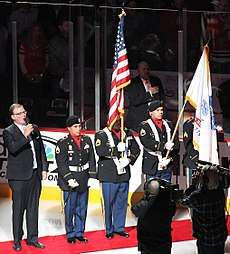
It is a tradition for Blackhawks fans to applaud and cheer loudly during the singing of the national anthem. This tradition originated during a 1985 Campbell Conference playoff game at Chicago Stadium versus the Edmonton Oilers.[181] Wayne Messmer, the Blackhawks home games national anthem singer from 1980 to 1994, was the anthem singer when this tradition began.[182] Jim Cornelison sings the national anthems for all home games and he is accompanied by organist Frank Pellico.[182] Before Game 2 of the 2010 Stanley Cup Finals at the United Center, the cheering during the anthem was registered between 116-122 decibels.[183]
Practice facilities
The Blackhawks practice facility, the Fifth Third Arena, is located in Chicago's Near West Side. The 125,000 square-foot facility opened in 2017 and cost $65 million to construct.[184] The Fifth Third Arena also serves as community center and hosts youth, high school, and adult hockey and ice skating programs.[185]
The Blackhawks had previously used Johnny's Ice House West and The Edge Ice Arena in suburban Bensenville as their practice facility.[186]
Circus trip
The Blackhawks and their arena mates, the Chicago Bulls, embarked on an annual two-week road trip in mid-November dating back to when both teams inhabited Chicago Stadium.[187] The Wirtz Family, who at one point owned the Blackhawks, Bulls, and Chicago Stadium, would lease the venue to circus acts and ice skating troupes.[188][189][190] The Blackhawks played between six and seven games in western Canada and California during this time.[187] In November 2016, the Ringling Bros. and Barnum & Bailey Circus announced they would not return to the United Center in 2017.[187] As a result, Disney On Ice performed its last two week show in 2017 before being condensed to one week in 2018.
Media and announcers
For the first time in team history, all 82 games plus playoffs were broadcast on television during the 2008–09 season. At least 20 of them aired on WGN-TV (Channel 9), the first time the Blackhawks had been seen on local over-the-air television in 30 years. Games produced by WGN-TV through its WGN Sports department are not available in its superstation feed WGN America due to league broadcast rights restrictions. Other games not broadcast by WGN-TV are aired on regional sports network NBC Sports Chicago, the first time in at least 35 years that non-nationally broadcast home games were seen locally, either over-the-air or on cable. On February 15, 2011, it was announced that the team had renewed their broadcast contract with WGN-TV for the next five years, starting in the 2011–12 NHL season. The deal was further extended for three more years on May 15, 2014, keeping the team on Channel 9 until the end of the 2018–19 season.[191] On January 2, 2019, the Blackhawks (along with the Chicago Bulls and Chicago White Sox) agreed to an exclusive multi-year deal with NBC Sports Chicago beginning with the 2019–20 season, ending the team's broadcasts on WGN-TV.[192]
Radio broadcasts since the 1970s and into the mid-2000s varied between WBBM (780) and WMAQ/WSCR (670), and often came into conflict with White Sox baseball by the start of April. On April 30, 2008, the team signed a three-year deal with WGN Radio (720 AM), with games airing alternately instead on WIND (560 AM) in scheduling conflict situations during the baseball season due to the Cubs having contractual preference to air on WGN; these moved to WGWG-LP (Channel 6/87.7 FM, an analog television station carrying an audio-only sports talk format using a quirk in the FM band) in mid-2014 when Tribune began a local marketing agreement with that station's owner. During the 2010 Stanley Cup Finals, the Cubs agreed to allow the Blackhawks games to be broadcast on WGN and have the Cubs revert to WIND when there was a conflict. This allowed the Finals games to be heard over a larger area due to WGN's clear-channel signal. All Blackhawk games are also streamed live on wgnradio.com, regardless of whether the games are on WGN or WGWG-LP. WLUP-FM (97.9 FM) was also utilized as an alternate station.
- Pat Foley – TV play-by-play
- Eddie Olczyk – Lead TV color commentator for NBC & TV color commentator for Blackhawks
- John Wiedeman – Radio play-by-play
- Troy Murray – Radio analyst
- Gene Honda – Public Address Announcer #1
- Jon Hansen - Public Address Announcer #2
- Luke Stuckmeyer – Rinkside reporter for games on NBC Sports Chicago
- Steve Konroyd – Analyst of Intermission, pre-game, and post-game shows, back-up TV color commentator
- Pat Boyle – Host of Intermission, pre-game, and post-game shows for games on NBC Sports Chicago
- Adam Burish – Analyst of Intermission, pre-game, and post-game shows for games on NBC Sports Chicago
- Patrick Sharp – Analyst of Intermission, pre-game, and post-game shows for games on NBC Sports Chicago
- Jamal Mayers – Analyst of Intermission, pre-game, and post-game shows for games on NBC Sports Chicago
- Chris Boden – Host of Intermission, pre-game, and post-game shows for games on WGN Radio
Season-by-season record
This is a partial list of the last five seasons completed by the Blackhawks. For the full season-by-season history, see List of Chicago Blackhawks seasons.
Note: GP = Games played, W = Wins, L = Losses, T = Ties, OTL = Overtime losses, Pts = Points, GF = Goals for, GA = Goals against
| Season | GP | W | L | OTL | Pts | GF | GA | Finish | Playoffs |
| 2015–16 | 82 | 47 | 26 | 9 | 103 | 235 | 209 | 3rd, Central | Lost in First Round, 3–4 (Blues) |
| 2016–17 | 82 | 50 | 23 | 9 | 109 | 244 | 213 | 1st, Central | Lost in First Round, 0–4 (Predators) |
| 2017–18 | 82 | 33 | 39 | 10 | 76 | 229 | 256 | 7th, Central | Did not qualify |
| 2018–19 | 82 | 36 | 34 | 12 | 84 | 270 | 292 | 6th, Central | Did not qualify |
| 2019–20 | 70 | 32 | 30 | 8 | 72 | 212 | 218 | 7th, Central | TBD |
Players
Current roster
Updated July 25, 2020[193][194]
Retired numbers
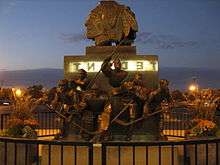
| No. | Player | Position | Career | No. retirement |
|---|---|---|---|---|
| 1 | Glenn Hall | G | 1957–1967 | November 20, 1988 |
| 3 | Keith Magnuson 1 | D | 1969–1980 | November 12, 2008 |
| Pierre Pilote 1 | D | 1955–1968 | November 12, 2008 | |
| 9 | Bobby Hull | LW | 1957–1972 | December 18, 1983 |
| 18 | Denis Savard | C | 1980–1990 1995–1997 | March 19, 1998 |
| 21 | Stan Mikita | C | 1958–1980 | October 19, 1980 |
| 35 | Tony Esposito | G | 1969–1984 | November 20, 1988 |
Notes:
- 1 Both players who wore #3 were honored.
- The NHL retired Wayne Gretzky's No. 99 for all its member teams at the 2000 NHL All-Star Game.[195]
Hall of Famers
The Chicago Blackhawks presently acknowledge an affiliation with a number of inductees to the Hockey Hall of Fame. Inductees affiliated with the Blackhawks include 41 former players and 10 builders of the sport.[196] The 10 individuals recognized as builders by the Hall of Fame includes former Blackhawks executives, general managers, head coaches, and owners. In addition to players and builders, the team recognizes an affiliation with three broadcasters who were awarded the Foster Hewitt Memorial Award from the Hockey Hall of Fame. Lloyd Pettit, a sportscaster, was the first Blackhawks broadcaster to receive the award, in 1986. Other Blackhawks broadcasters awarded the Foster Hewitt Memorial Award include Pat Foley (awarded in 2014).[196] In 2016, team historian Bob Verdi was awarded the Elmer Ferguson Memorial Award.[197]
| Chicago Blackhawks Hall of Famers | ||||||
|---|---|---|---|---|---|---|
| Affiliation with inductees based on team acknowledgement | ||||||
| Hall of Fame players[196] | ||||||
| Sid Abel Lionel Conacher Tony Esposito Glenn Hall Ted Lindsay Bert Olmstead Allan Stanley |
Ed Belfour Roy Conacher Phil Esposito George Hay Harry Lumley Bobby Orr John Stewart |
Doug Bentley Chris Chelios Bill Gadsby Bobby Hull Mickey MacKay Pierre Pilote Harry Watson |
Max Bentley Paul Coffey Charlie Gardiner Marian Hossa Dick Irvin Stan Mikita Denis Savard |
Georges Boucher Art Coulter Doug Gilmour Duke Keats Howie Morenz Earl Seibert Doug Wilson |
Frank Brimsek Babe Dye Michel Goulet Hugh Lehman Bill Mosienko Clint Smith |
|
| Hall of Fame builders[196] | ||||||
| Al Arbour Rudy Pilous |
Thomas N. Ivan Bud Poile |
John Mariucci Arthur Wirtz |
Frederic McLaughlin Bill Wirtz |
James D. Norris | James E. Norris | |
Team captains
- Dick Irvin, 1926–1929
- Duke Dukowski, 1929–1930
- Ty Arbour, 1930–1931
- Marvin Wentworth, 1931–1932
- Helge Bostrom, 1932–1933
- Charlie Gardiner, 1933–1934
- Johnny Gottselig, 1935–1940
- Earl Seibert, 1940–1942
- Doug Bentley, 1942–1944, 1949–1950
- Clint Smith, 1944–1945
- John Mariucci, 1945–1946, 1947–1948
- Red Hamill, 1946–1947
- Gaye Stewart, 1948–1949
- Jack Stewart, 1950–1952
- Bill Gadsby, 1952–1954
- Gus Mortson, 1954–1957
- Ed Litzenberger, 1958–1961
- Pierre Pilote, 1961–1968
- Pat Stapleton, 1969–1970
- Pit Martin, 1975–1976
- Pit Martin; Stan Mikita; Keith Magnuson, 1976–1977
- Keith Magnuson, 1977–1979
- Terry Ruskowski, 1979–1982
- Darryl Sutter, 1982–1987
- Bob Murray, 1985–1986 (interim)
- Denis Savard, 1988–1989
- Dirk Graham, 1989–1995
- Chris Chelios, 1995–1999
- Doug Gilmour, 1999–2000
- Tony Amonte, 2000–2002
- Alexei Zhamnov, 2002–2004
- Adrian Aucoin; 2005–2007
- Martin Lapointe; 2006 (interim)
- Jonathan Toews, 2008–present
Franchise scoring leaders
These are the top-ten point-scorers in franchise history. Figures are updated after each completed NHL regular season.
- * – current Blackhawks player
Note: Pos = Position; GP = Games played; G = Goals; A = Assists; Pts = Points; P/G = Points per game
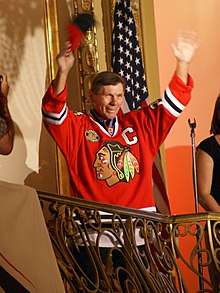
|
|
|
See also
References
- Diamond, Dan (1991). The Official National Hockey League 75th anniversary commemorative book. Toronto, Ontario: McClelland & Stewart. ISBN 0-7710-6727-5.CS1 maint: ref=harv (link)
- Jenish, D'Arcy (2013). The NHL: 100 Years of On-Ice Action and Boardroom Battles. Random House LLC. ISBN 9780385671477.CS1 maint: ref=harv (link)
- Skog, Jason (2008). The Story of the Chicago Blackhawks. The Creative Company. ISBN 9781583416150.CS1 maint: ref=harv (link)
- Vass, George (1970). The Chicago Black Hawks Story. Chicago, IL: Follett Publishing Company. ISBN 0-695-80202-X.CS1 maint: ref=harv (link)
- Notes
- "Front Office". ChicagoBlackhawks.com. NHL Enterprises, L.P. Retrieved February 19, 2017.
- "1959-2018 Chicago Blackhawks–Greatest NHL Uniforms". GreatestNHLUniforms.com. NHL Enterprises, LP. Archived from the original on March 24, 2018. Retrieved May 31, 2018.
- Horn, Toby (2002). "Blackhawks". Stadiums. 2 (1): 56–80.
- Jenish 2013, pp. 46–47.
- Jenish 2013, p. 52.
- "The McLaughlin Years". United Center. Retrieved June 21, 2010.
- Diamond 1991, p. 291.
- Vass 1970, p. 16.
- Morreale, Mike G. (May 29, 2010). "Anthem in Chicago a tradition like no other". NHL.com/Blackhawks. NHL Enterprises. Retrieved July 28, 2020.
- Ledra, Cristina; Pickens, Pat (November 22, 2016). "NHL team nicknames explained". NHL.com. NHL Enterprises. Retrieved July 28, 2020.
The team name officially became Blackhawks, one word, like the military division, in 1986.
- "Top Sports Searches - ESPN". Archived from the original on September 13, 2007.
- Stewart, Larry (March 31, 2004). "This Game Is Still No Place for Cheetahs". Los Angeles Times. Archived from the original on December 10, 2015. Retrieved March 9, 2017.
- "Blackhawks owner William Wirtz dies of cancer". Canadian Broadcasting Corporation. September 26, 2007. Retrieved February 28, 2009.
- Smith, Bryan (November 2008). "The Breakaway". Chicago Magazine. Retrieved February 28, 2009.
- Hollencamp, Kate (February 11, 2009). "Losing may be the secret to Blackhawks president's success". Medill Reports. Archived from the original on February 13, 2009. Retrieved February 28, 2009.
- "McDonough Named Blackhawks President". National Hockey League. November 20, 2007. Archived from the original on February 29, 2008. Retrieved February 28, 2009.
- Greenstein, Teddy (February 2, 2009). "Blackhawks President John McDonough pushes staff to think bigger". Chicago Tribune. Archived from the original on February 9, 2009. Retrieved February 28, 2009.
- "Hull, Mikita rekindle Blackhawks ties". Sporting News. March 7, 2008. Retrieved February 28, 2009.
- Sassone, Tim (October 5, 2007). "Culture shock hits Hawks". The Daily Herald. Archived from the original on October 11, 2007. Last. Retrieved October 6, 2007.
- Burnside, Scott (December 15, 2007). "Rookie Kane growing on fans and teammates alike". ESPN. Retrieved February 28, 2009.
- Vogl, John (June 13, 2008). "Kane able to raise Calder Trophy". buffalonews.com. Archived from the original on July 2, 2008. Retrieved February 28, 2009.
- Kuc, Chris (March 12, 2008). "Hawks shut out—and likely shut out of playoffs". Chicago Tribune. Retrieved February 28, 2009.
- "'Hawks get Ladd from 'Canes for Ruutu". Sporting News. February 26, 2008. Retrieved May 7, 2009.
- Boston, Ryan (July 1, 2008). "Brian Campbell Signs with the Chicago Blackhawks for Eight Years and $56.8M". Bleacher Report. Retrieved May 7, 2009.
- "Blackhawks Add Mike Haviland To Coaching Staff". Chicago Blackhawks. July 23, 2008. Archived from the original on August 26, 2008. Retrieved November 2, 2008.
- Dreger, Darren (September 26, 2008). "Dreger: Quenneville Finds Spot with Hawks". The Sports Network. Archived from the original on February 1, 2014. Retrieved November 2, 2008.
- "Hockey Hall of Famer Scotty Bowman Joins Blackhawks". Chicago Blackhawks. July 31, 2008. Archived from the original on August 19, 2008. Retrieved November 2, 2008.
- "Hawks, Wings to play Jan. 1 at Wrigley Field".
- "Chicago Tribune.com: February 2008 Transactions". Retrieved June 20, 2008.
- "Pat Foley Bio – Chicago Blackhawks – Team". National Hockey League. July 23, 2008. Archived from the original on February 3, 2012. Retrieved March 3, 2013.
- "Blackhawks Announce Head Coaching Change". National Hockey League. October 16, 2008. Archived from the original on October 17, 2008. Retrieved October 16, 2008.
- "Blackhawks advance for first time since 1996". April 27, 2009. Retrieved April 28, 2009.
- "'Hawks win a wild one, advance to West finals". National Hockey League. May 11, 2009. Retrieved May 12, 2009.
- Lage, Larry (May 28, 2009). "Helm's OT goal puts Red Wings back in Cup finals". Yahoo! Sports. Retrieved May 28, 2009.
- "NHL Attendance – 2009". ESPN. February 27, 2008. Retrieved February 27, 2009.
- "Blackhawks To Hit One Million Fan Mark Before Game 6 on Monday". National Hockey League. May 11, 2008. Archived from the original on May 15, 2009. Retrieved May 17, 2009.
- LeBrun, Pierre (July 2, 2009). "Hossa, Blackhawks agree on deal". ESPN. Retrieved July 14, 2009.
- "Blackhawks sign veteran center John Madden". Yahoo! Sports. Associated Press. July 2, 2009. Retrieved July 14, 2009.
- "NHLPA files grievance against Blackhawks over free-agent glitch". Sports Illustrated. Associated Press. July 6, 2009. Archived from the original on July 10, 2009. Retrieved July 14, 2009.
- "Blackhawks Promote Stan Bowman To General Manager". National Hockey League. July 14, 2009. Archived from the original on July 16, 2009. Retrieved 2009-07-14.
- Wharnsby, Tim (June 9, 2010). "Blackhawks end 49-year Stanley Cup drought". CBC Sports. Retrieved November 16, 2016.
- LeBrun, Pierre (June 24, 2010). "Blackhawks trade away Byfuglien". ESPN. Archived from the original on February 2, 2017. Retrieved March 9, 2017.
- Lipsman, Benjy (July 1, 2010). "Blackhawks Trade Versteeg". Chicagoist. Archived from the original on March 9, 2017. Retrieved March 9, 2017.
- Rogers, Jesse (December 14, 2010). "Crawford did best to rescue Turco, Hawks". ESPN. Archived from the original on March 9, 2017. Retrieved March 9, 2017.
- "Blackhawks acquire Frolik and Salak from Florida". National Hockey League. February 11, 2011. Archived from the original on March 9, 2017. Retrieved March 9, 2017.
- Brothers, Bruce (April 11, 2011). "Wild 5, Stars 3: Minnesota's season-finale victory keeps Dallas out of playoffs". Twin Cities. Pioneer Press. Archived from the original on March 9, 2017. Retrieved March 9, 2017.
- Sarcu, Sean (December 21, 2013). "The Rise and Fall of the Blackhawks / Canucks Rivalry". The Hockey Writers. Archived from the original on December 20, 2016. Retrieved March 9, 2017.
- LeBrun, Pierre (June 25, 2011). "Hawks deal Brian Campbell to Panthers". ESPN. Archived from the original on March 9, 2017. Retrieved March 9, 2017.
- Kuc, Chris (July 1, 2011). "Blackhawks sign 5 veteran free agents". Chicago Tribune. Archived from the original on August 19, 2014. Retrieved March 9, 2017.
- Kuc, Chris (October 3, 2011). "Emery wins Blackhawks' backup goalie job". Chicago Tribune. Retrieved October 3, 2011.
- Powers, Scott (June 25, 2014). "Blackhawks draft review: 2011 class". ESPN. Archived from the original on March 9, 2017. Retrieved March 9, 2017.
- "Front Office - Game Insider" (PDF). National Hockey League. March 29, 2012. Archived (PDF) from the original on March 9, 2017. Retrieved March 9, 2017.
- Rubin, Marc (April 24, 2012). "NHL Playoffs 2012: How the Phoenix Coyotes Beat the Chicago Blackhawks". Bleacher Report. Archived from the original on March 9, 2017. Retrieved March 9, 2017.
- Kuc, Chris (January 27, 2013). "Leddy's OT goal gives Hawks best start in team history". Chicago Tribune. Archived from the original on January 29, 2013. Retrieved March 9, 2017.
- Kuc, Chris (January 27, 2013). "Canucks tip Blackhawks 3-2 in a shootout". Chicago Tribune. Archived from the original on December 21, 2013. Retrieved March 9, 2017.
- Pinchevsky, Tal (March 8, 2013). "Blackhawks' historic run comes to an end". National Hockey League. Archived from the original on March 9, 2017. Retrieved March 9, 2017.
- "Blackhawks' streak ends at 24 with loss to Avalanche". National Hockey League. March 8, 2013. Archived from the original on March 13, 2013. Retrieved March 10, 2013.
- FlyersHistory.net, Some Facts & Figures About the Streak.
- "Old Flyers know what makes a streak". ESPN. February 27, 2013. Retrieved March 7, 2013.
- Powers, Scott (March 1, 2013). "Rapid Reaction: Hawks 4, Jackets 3". ESPN. Archived from the original on March 9, 2017. Retrieved March 9, 2017.
- Carrera, Katie (June 25, 2013). "2013 Stanley Cup Final: Blackhawks are champions second time in four years". The Washington Post. Archived from the original on March 9, 2017. Retrieved March 9, 2017.
- "Hawks eliminate Wings in OT, advance to Western finals". CBS Sports. May 29, 2013. Archived from the original on March 9, 2017. Retrieved March 9, 2017.
- Strauss, Ben (June 9, 2013). "Kane Finishes Hat Trick, and Kings, in a Thriller". The New York Times. Archived from the original on December 24, 2016. Retrieved March 9, 2017.
- Maynard, Micheline (June 9, 2013). "Boston Bruins Vs Chicago Blackhawks: Can The Original Six Create TV Buzz?". Forbes. Archived from the original on October 25, 2013. Retrieved March 9, 2017.
- National Hockey League (2010). The National Hockey League Official Guide & Record Book/2011. Triumph Books. p. 39. ISBN 978-1-60078-422-4.
- Kuc, Chris (June 30, 2013). "Salary cap will force Blackhawks to make some tough decisions". Chicago Tribune. Retrieved June 16, 2015.
- Rosen, Dan (June 30, 2013). "Blackhawks re-sign Bickell; trade Bolland, Frolik". National Hockey League. Retrieved June 16, 2015.
- Leahy, Sean (March 1, 2014). "Blackhawks rout Penguins 5–1 in snowy conditions in NHL Stadium Series game". Yahoo! Sports. Retrieved June 16, 2015.
- Stewart, Monte (January 30, 2014). "Hawks push Quenneville into 3rd for wins". ESPN. Retrieved June 16, 2015.
- "Patrick Sharp helps Blackhawks earn 2,500th win in team history". ESPN. Associated Press. October 15, 2013. Retrieved June 16, 2015.
- Hamilton, Brian (April 27, 2014). "2014 NHL Playoffs: Blackhawks eliminate Blues with 5–1 win in Game 6". Sports Illustrated. Retrieved June 16, 2015.
- Cohen, Jay (June 2, 2015). "Kings beat Blackhawks 5–4 in OT in Game 7". Yahoo! Sports. Retrieved June 16, 2015.
- Roarke, Shawn (June 24, 2014). "Keith wins Norris Trophy for second time". National Hockey League. Retrieved June 16, 2015.
- Cooper, Josh (June 24, 2014). "Patrice Bergeron, Anze Kopitar, Jonathan Toews voted Selke Trophy finalists". Yahoo! Sports. Retrieved June 16, 2015.
- "Blackhawks sign veteran center Brad Richards". ESPN. July 1, 2014. Retrieved July 1, 2014.
- "Blackhawks agree to terms with three". Chicago Blackhawks. July 1, 2014. Retrieved July 1, 2014.
- "Nick Leddy's deal worth $38.5M". ESPN. February 24, 2015. Retrieved February 24, 2015.
- Powers, Scott (March 7, 2015). "Blackhawks midseason awards". ESPN. Retrieved June 16, 2015.
- Kimmelman, Adam (January 3, 2015). "Girgensons, five Blackhawks named first 6 All-Stars". National Hockey League. Retrieved January 24, 2015.
- "Nationals Park to Host Capitals vs. Blackhawks in 2015 Bridgestone NHL Winter Classic". September 10, 2014. Retrieved September 10, 2014.
- Powers, Scott (February 25, 2015). "Patrick Kane of Chicago Blackhawks undergoes surgery, expected out 12 weeks". ESPN. Retrieved March 2, 2015.
- "Vermette acquired by Blackhawks for steep deadline price". Yahoo! Sports. February 28, 2015. Retrieved February 28, 2015.
- "Flyers trade Kimmo Timonen to Blackhawks". CSN Philly. February 27, 2015. Archived from the original on February 28, 2015. Retrieved 2015-02-27.
- "Blackhawks trade Ben Smith to San Jose for Andrew Desjardins". Chicago Sun-Times. March 2, 2015. Archived from the original on March 4, 2015. Retrieved March 2, 2015.
- Neveau, James (April 12, 2015). "Corey Crawford Nabs William Jennings Trophy Saturday". NBC Chicago. Retrieved April 20, 2015.
- Hine, Chris (April 14, 2015). "Blackhawks' Patrick Kane to return for Game 1 vs. Predators". Chicago Tribune. Retrieved June 16, 2015.
- Masisak, Corey (May 8, 2015). "Blackhawks sweep Wild, advance to conference final". National Hockey League. Retrieved June 16, 2015.
- Belson, Ken (June 16, 2015). "With Blackhawks' 3 Stanley Cups in 6 Years, Chicago Runneth Over". The New York Times. Retrieved June 16, 2015.
- Lazerus, Mark (June 17, 2015). "Brandon Saad open to giving Hawks a hometown discount". Chicago Sun-Times. Archived from the original on June 18, 2015. Retrieved June 18, 2015.
- Peters, Chris (June 30, 2015). "Blackhawks trade Brandon Saad to Blue Jackets in 7-player deal". CBS Sports. Retrieved June 30, 2015.
- Kuc, Chris (July 1, 2015). "Brad Richards and Antoine Vermette make it official – they're gone". Chicago Tribune. Retrieved July 2, 2015.
- Lazerus, Mark (July 10, 2015). "Blackhawks trade Patrick Sharp to Dallas Stars". Chicago Sun-Times. Archived from the original on July 12, 2015. Retrieved July 10, 2015.
- "BLACKHAWKS: ARTEMI PANARIN LOCKS IN FIRST GOAL OF 2015-16 SEASON". Comcast SportsNet Chicago. October 7, 2015. Retrieved May 3, 2016.
- Wyshynski, Greg (June 22, 2016). "Patrick Kane becomes first U.S. player to win Ted Lindsay Award". Yahoo! Sports. Retrieved June 23, 2016.
- "Artemi Panarin wins Calder Trophy". National Hockey League. Retrieved June 22, 2016.
- "Leafs acquire Morin from Blackhawks". TSN. January 3, 2016. Retrieved January 3, 2016.
- "Blackhawks make big move in bringing back winger Andrew Ladd". Chicago Tribune. February 25, 2016. Retrieved February 25, 2016.
- "Canadiens trade Weise, Fleischmann to Blackhawks for Danault and a pick". Sportsnet.ca. February 26, 2016. Retrieved February 26, 2016.
- Korac, Louie (April 25, 2016). "Blues defeat Blackhawks in Game 7". National Hockey League. Retrieved April 25, 2016.
- Timmermann, Tom (April 22, 2016). "Blackhawks are experts at winning Game 6". St. Louis Post-Dispatch. Retrieved November 22, 2016.
- "Canadiens acquire forward Andrew Shaw". Sportsnet.ca. June 24, 2016. Retrieved June 24, 2016.
- Muir, Allan (June 15, 2016). "Blackhawks pay heavy price to move Bryan Bickell's contract". Sports Illustrated. Retrieved September 30, 2016.
- Emma, Chris (July 1, 2016). "Brian Campbell Returns To Chicago: 'It's Where My Heart Is'". CBS Chicago. Retrieved November 22, 2016.
- "Blackhawks agree to terms with Johansson, Kempny and Lundberg". Chicago Blackhawks. May 23, 2016. Retrieved May 23, 2016.
- Dietz, John (October 10, 2016). "Six rookies crack Chicago Blackhawks roster". Daily Herald. Retrieved November 22, 2016.
- Vollman, Rob (April 10, 2017). "Blackhawks vs. Predators key statistics". National Hockey League. Retrieved April 21, 2017.
- McLaren, Ian (March 22, 2017). "Panik makes Blackhawks". 670 The Score. Retrieved April 26, 2017.
- Kuc, Chris (January 10, 2017). "4 Blackhawks selected for NHL All-Star Game". Chicago Tribune. Retrieved April 21, 2017.
- "NHL Playoffs: Predators deliver Blackhawks first top seed sweep in opening-round". The Post-Standard. April 21, 2017. Retrieved April 23, 2017.
- "PREDATORS BEAT BLACKHAWKS 4-1 TO COMPLETE SWEEP". ABC Chicago. April 21, 2017. Archived from the original on April 21, 2017. Retrieved April 21, 2017.
- "Medical update on Marian Hossa". National Hockey League. June 21, 2017. Retrieved June 21, 2017.
- "Marian Hossa reveals skin disorder, to miss season". ESPN. June 21, 2017. Archived from the original on June 21, 2017. Retrieved June 21, 2017.
- Lazerus, Mark (June 23, 2017). "Blackhawks deal Panarin for Saad; ship Hjalmarsson to Arizona". Chicago Sun-Times. Archived from the original on June 23, 2017. Retrieved June 23, 2017.
- Hedger, Brian (August 6, 2017). "Inside look at Chicago Blackhawks". National Hockey League. Archived from the original on August 7, 2017. Retrieved August 7, 2017.
- Hine, Chris (October 5, 2018). "Blackhawks off to a blistering start with 10-1 rout of defending champs Penguins". Chicago Tribune. Retrieved March 21, 2018.
- Powers, Scott (February 5, 2018). "Powers points: Path to playoff spot getting harder to picture for Blackhawks". The Athletic. Retrieved March 21, 2018.
- Neveau, James (January 5, 2018). "Quenneville Provides Corey Crawford Injury Update". NBC Chicago. Retrieved January 14, 2018.
- Hine, Chris (October 30, 2018). "Blackhawks' struggling power play might have too many 'creative minds'". Chicago Tribune. Retrieved March 21, 2018.
- Skrbina, Paul (March 20, 2018). "Blackhawks eliminated from playoff contention for 1st time in 10 years". Chicago Tribune. Retrieved March 21, 2018.
- "Blackhawks end season with 4-1 loss to Jets". WGN. Associated Press. April 7, 2018. Retrieved April 8, 2018.
- "Blackhawks agree to terms with three". Chicago Blackhawks. July 1, 2018. Retrieved July 1, 2018.
- "Marian Hossa's contract to Coyotes in multiplayer deal". ESPN. July 12, 2018. Retrieved July 12, 2018.
- Greenfield, Jimmy (November 4, 2018). "Analysis: Winless road trip should not be viewed as a surprise for slumping Blackhawks". Chicago Tribune. Retrieved November 7, 2018.
- "RELEASE: Blackhawks make coaching change". National Hockey League. November 6, 2018. Retrieved November 6, 2018.
- "Coyotes Acquire Schmaltz from Chicago in Exchange for Perlini and Strome". NHL.com. November 25, 2018. Retrieved November 26, 2018.
- "Oilers acquire Brandon Manning and Robin Norell". Edmonton Oilers. December 30, 2018. Retrieved December 30, 2018.
- Lieser, Jason (January 18, 2019). "Winter storm: Blackhawks buried at bottom of NHL as losses pile up again". Chicago Sun-Times. Retrieved April 22, 2019.
- Greenfield, Jimmy (April 5, 2019). "Blackhawks hoping their 2nd-half success carries over to avoid another slow start next season". Chicago Tribune. Retrieved April 22, 2019.
- Lieser, Jason (April 9, 2019). "NHL Draft lottery results 2019: Blackhawks pick No. 3". Chicago Sun-Times. Retrieved April 22, 2019.
- Piller, Thomas (July 9, 2019). "Chicago Blackhawks ink 3rd overall draft pick Kirby Dach". Global News. Retrieved May 28, 2020.
- Greenfield, Jimmy (July 1, 2019). "After Blackhawks sign goalie Robin Lehner and center Ryan Carpenter on 1st day of free agency, GM Stan Bowman says: 'We have a pretty full roster'". Chicago Tribune. Retrieved May 28, 2020.
- Cohen, Jay (July 9, 2019). "Blackhawks acquire F Alex Nylander in trade with Sabres". AP News. Retrieved May 28, 2020.
- "RELEASE: Blackhawks acquire Andrew Shaw and draft pick". Chicago Blackhawks. June 30, 2019. Retrieved June 30, 2019.
- "RELEASE: Blackhawks agree to terms with Kubalik". Chicago Blackhawks. May 29, 2019. Retrieved May 29, 2019.
- "NHL pauses regular season because of coronavirus". NHL.com. March 12, 2020. Retrieved March 20, 2020.
- "RELEASE: Blackhawks Release John McDonough". NHL.com. NHL. April 27, 2020. Retrieved June 9, 2020.
- "NHL plans to return with 24 teams competing for Stanley Cup". NHL.com. Retrieved May 26, 2020.
- Thompson, Phil (August 8, 2020). "Blackhawks advance to the 1st round of the NHL playoffs after beating the Oilers 3-2 in Game 4". Chicago Tribune. Retrieved August 8, 2020.
- "Chicago Blackhawks - The (unofficial) NHL Uniform Database". NHL Uniform Database. 2017. Archived from the original on December 8, 2016. Retrieved March 9, 2017.
- Fromi, Jon (August 26, 2011). "Chicago Blackhawks: Third Sweater? We Don't Need No Stinkin' Third Sweater!". Bleancher Report. Archived from the original on March 9, 2017. Retrieved March 9, 2017.
- Paul, Lukas (September 27, 2007). "Skating on thin ice". ESPN. Archived from the original on March 9, 2017. Retrieved March 9, 2017.
- "Best NHL third jerseys". ESPN. December 4, 2001. Archived from the original on March 9, 2017. Retrieved March 9, 2017.
- Hine, Chris (June 26, 2013). "Classic Blackhawks sweater remains one of the most iconic in sports". Chicago Tribune. Archived from the original on November 4, 2014. Retrieved March 10, 2017.
- "The Hockey News' NHL Jersey Rankings". The Hockey News. August 10, 2009. Archived from the original on March 17, 2016. Retrieved September 7, 2009.
- Wyshynski, Greg (March 10, 2017). "What are the top 5 NHL jerseys of all-time? (Video)". Yahoo! Sports. Archived from the original on March 10, 2017. Retrieved March 10, 2017.
- Stubbs, David (January 2, 2018). "Blackhawks voted Greatest NHL Uniform". National Hockey League. Archived from the original on January 2, 2018. Retrieved January 2, 2018.
- "Hawks to salute veterans with camo-jersey auction". Daily Herald. November 9, 2009. Retrieved November 16, 2009.
- "'Hawks and Wings to sport retro jersey outdoors". National Hockey League. October 25, 2008. Archived from the original on March 19, 2009. Retrieved October 30, 2008.
- "2014 Stadium Series Jersey Unveiled". National Hockey League. Retrieved March 29, 2014.
- "Chicago Blackhawks Take It Back to the 50s With 2015 Winter Classic Jerseys". sportslogos. Retrieved March 23, 2015.
- "Blackhawks, Wild Unveil Stadium Series Jerseys". sportslogos. Retrieved November 28, 2015.
- "Blues, Blackhawks Winter Classic Uniforms Officially Unveiled". sportslogos. Retrieved January 7, 2017.
- "NHL Unveils Trio of New Logos for Centennial Year". sportslogos. Retrieved January 7, 2017.
- Creamer, Chris (January 2, 2017). "Pics: Centennial Patches Added to All NHL Teams". SportsnetLogos.net. Wordpress. Retrieved June 14, 2017.
- "NHL, adidas unveil uniforms". National Hockey League. Retrieved June 24, 2017.
- "Adidas Unveils A New Look for the NHL". SportsLogos.net. Retrieved June 24, 2017.
- "BLOG: Blackhawks honor Mikita with patches". National Hockey League. Retrieved August 10, 2018.
- "Almost time". Twitter. Retrieved August 10, 2018.
- "RELEASE: Blackhawks unveil Winter Classic jersey". National Hockey League. Retrieved September 11, 2018.
- "RELEASE: Blackhawks to wear Winter Classic jersey at three home games". NHL.com. January 4, 2019. Retrieved January 6, 2019.
- "=BLOG: Blackhawks debut 2019-20 adidas adizero jersey". National Hockey League. Retrieved April 10, 2019.
- "=BLOG: Blackhawks officially acknowledge new jersey collar". icethetics.com. Retrieved April 10, 2019.
- Skog 2008.
- "THN.com's NHL Logo Rankings". The Hockey News. August 1, 2008. Archived from the original on July 24, 2016. Retrieved March 3, 2013.
- March 2, 2013 10:22 pm EST Facebook Twitter RSS (May 28, 2010). "Cox: Offensive Blackhawks logo has got to go". Toronto Star. Retrieved March 3, 2013.
- http://www.ncai.org/resources/ncai-publications/Ending_the_Legacy_of_Racism.pdf
- Kuc, Chris (November 12, 2011). "Hawks developing ties to Native Americans". Chicago Tribune. Retrieved February 19, 2015.
- mlarson (June 19, 2013). "Wearing Someone Else's Culture: More on the Chicago Blackhawks". Archived from the original on September 30, 2015. Retrieved October 31, 2015.
- "Protests rare over Blackhawks' name, logo". Chicago Tribune.
- https://aicchicago.org/statement-aic-ends-ties-with-chicago-blackhawks-foundation/
- https://aicchicago.org/statement-on-blackhawks/
- "Chicago Blackhawks release statement defending name, logo". TSN. July 7, 2020. Retrieved July 8, 2020.
- "TOMMY HAWK". National Hockey League. March 9, 2017. Archived from the original on February 11, 2017. Retrieved March 9, 2017.
- O'Brien, Katie (September 17, 2013). "The origins of Chicago's sports mascots". WBEZ. Archived from the original on March 9, 2017. Retrieved March 9, 2017.
- Wogenrich, Mark (June 16, 2019). "Penn State's Nittany Lion mascot is a Hall of Famer". The Morning Call. Archived from the original on June 16, 2019. Retrieved June 16, 2019.
- Rosenbloom, Steve; Litton, Drew (October 8, 2014). "Faker's guide to the Blackhawks". Chicago Tribune. Retrieved November 4, 2016.
- Norton, Justin (July 31, 2013). "Exclusive Interview: Ministry's Al Jourgensen on His Memoir, Hockey, and Hanging with Republican Neighbors". MetalSucks. Retrieved November 4, 2016.
- Grossman, Evan (April 25, 2016). "The history behind the NHL's ubiquitous sound for scoring: the goal horn". Daily News. New York. Retrieved November 4, 2016.
- Hedger, Brian (June 1, 2010). "'Chelsea Dagger' has become hit for Hawks' fans". National Hockey League. Retrieved November 4, 2016.
- George, Jason (November 10, 2008). "Teamwork keeps the fun moving at Blackhawks hockey games". Chicago Tribune. Retrieved November 4, 2016.
- Boron, Brad (October 24, 2008). "National Anthem a Chicago specialty". Retrieved October 26, 2008.
- Strauss, Ben (June 10, 2013). "How the National Anthem Turned into A Blackhawks Rallying Cry". The New York Times. Retrieved December 18, 2016.
- "How loud is it? Game 2 decibel readings". National Hockey League. June 1, 2010. Archived from the original on January 27, 2017. Retrieved March 9, 2017.
- Skrbina, Paul (November 16, 2017). "Jonathan Toews on Blackhawks' new practice facility: 'Christmas came early'". Chicago Tribune. Retrieved November 18, 2017.
- "Fifth Third Arena Chicago Blackhawks Community Ice Rink".
- "Blackhawks say goodbye to Johnny's IceHouse West". nbcsports.com. Retrieved April 26, 2019.
- Kuc, Chris (November 14, 2016). "Say goodbye to the circus trip: Scheduling quirk to end for Blackhawks, Bulls". Chicago Tribune. Retrieved November 14, 2016.
- Weintraub, Jerry (March 2011). When I Stop Talking, You'll Know I'm Dead: Useful Stories from a Persuasive Man. New York, New York: Twelve. ISBN 978-0446548168.
- Limpsman, Benjy (November 16, 2009). "Bulls, Hawks Head West As Circus Comes to Town". Chicagoist. Archived from the original on January 2, 2010. Retrieved November 15, 2016.
- Elsner, David (May 20, 1976). "Arthur M. Wirtz built giant empire with close deals and little flash". Chicago Tribune. Chicago. Retrieved November 14, 2016.
- "Blackhawks announce 3-year contract extension with WGN-TV". WGN-TV. May 15, 2014. Retrieved May 23, 2014.
- "NBC Sports Chicago Announces New Pact With White Sox, Bulls, and Blackhawks". WMAQ-TV. January 2, 2019. Retrieved January 4, 2019.
- "Chicago Blackhawks Roster". National Hockey League. Retrieved February 19, 2018.
- "Chicago Blackhawks Hockey Transactions". The Sports Network. Retrieved February 19, 2018.
- "Perfect setting: Gretzky's number retired before All-Star Game". CNN Sports Illustrated. Associated Press. February 6, 2000. Archived from the original on November 12, 2013. Retrieved June 9, 2014.
- "Blackhawks in the Hockey Hall of Fame". Chicago Blackhawks. 2018. Retrieved April 11, 2018.
- Brian Hedger (November 7, 2016). "Bob Verdi 'blown away' by Hall of Fame honor". NHL.com. Retrieved April 1, 2019.
Further reading
- Goyens, Chrys; Orr, Frank; Turowetz, Allan; Duguay, Jean-Luc (2000). Blades on ice : a century of professional hockey. TPE Publishing. ISBN 0968622003.
- MacFarlane, Brian (2000). The Blackhawks. Toronto, Ontario: Stoddart Publishing. ISBN 0773732527.CS1 maint: ref=harv (link)
- Pfeiffer, Gerald L. (1986). The Chicago Blackhawks : a sixty year history, 1926–1986. Chicago, Illinois: Windy City Pub. Co.CS1 maint: ref=harv (link)
- Weinberg, Mark (2000). Career Misconduct: The Story of Bill Wirtz's Greed, Corruption, and the Betrayal of Blackhawks' Fans. Blueline Publishing, Inc. ISBN 9780965631204.CS1 maint: ref=harv (link)
- Wong, John Chi-Kit (2005). Lords of the Rinks: The Emergence of the National Hockey League, 1875–1936. University of Toronto Press.CS1 maint: ref=harv (link)

